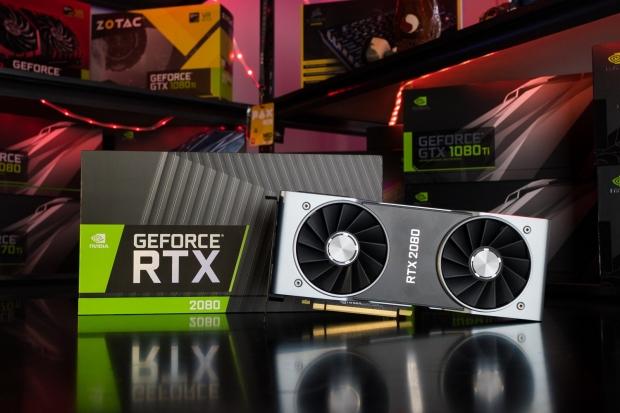
The Bottom Line
Introduction & Pricing/Availability
It's finally here, like... really, finally here.
NVIDIA's new Turing GPU architecture makes its first consumer graphics cards with the GeForce RTX 2080 Ti and RTX 2080, and the upcoming RTX 2070 that will launch next month. NVIDIA had only just unveiled the next-gen Turing GPU architecture the month before at SIGGRAPH 2018, where it unveiled new Quadro RTX branded graphics cards that fanned the flames of the rumor mill of a brand change to RTX.
We heard last year that NVIDIA were going to be mixing up the branding of the cards, but not to the extent of retiring the GTX moniker. NVIDIA's new Turing GPU architecture has ray tracing at its soul, with new RT Cores and Tensor Cores that it has borrowed from the Volta GPU architecture. Turing was built from the ground up for ray tracing, and was in development for 10 years alongside the development of previous GPU architectures in Maxwell and Pascal.
NVIDIA's new Turing GPU is the 'greatest leap since 2006 CUDA GPU', with the Turing GPU split into three: the Turing SM, RT Core, and Tensor Cores (NGX).
NVIDIA introduces RTX-OPS with the new GeForce RTX 20 series graphics cards, a way of measuring its ray tracing performance as well as Giga Rays/s to confuse us all. The new flagship GeForce RTX 2080 Ti is a freaking beast with 10 Giga Rays/s and 78T RTX-OPS with 11GB of GDDR6, while the RTX 2080 is knocked down to 8 Giga Rays/s and 60T RTX-OPS and 8GB of GDDR6, while the RTX 2070 that comes out next month will have 6 Giga Rays/s and 45T RTX-OPS with 8GB of GDDR6.
Putting The 'RT' in GeForce RTX
NVIDIA calling their new Turing graphics cards for consumers 'GeForce RTX' is the biggest shift in marketing for the company since the introduction of the GTX brand. RTX has a big road ahead of itself, as now NVIDIA is absolutely 100% committed to the world of ray tracing. We won't see NVIDIA move back to the GeForce GTX branding, ever.
The future of gaming is in real-time ray tracing, where NVIDIA is so far ahead it will be able to define the entire ray tracing industry. This is both a good, and a bad thing... as it gives NVIDIA full control of the entire ray tracing market right now. AMD is a player in the workstation space, but none of its consumer GPU architectures are capable of real-time ray tracing. Radeon is dead in the water for now, but I'm sure that's going to change with Navi... it has to change with Navi.
Pricing & Availability
NVIDIA is pricing its new GeForce RTX 20 series cards at much higher prices than previous-gen launches, but then again the company never launches its 'Ti' variant at launch so these are different times. The new GeForce RTX 2080 Ti Founders Edition launches at $1199, the same price as the Pascal-based TITAN Xp. But the RTX 2080 Ti overall, starts at $999 while NVIDIA's higher-end Founders Edition knocks the price up to $1199.
- GeForce RTX 2080 Ti - $999-$1199
- GeForce RTX 2080 - $699-$799
- GeForce RTX 2070 - $599
NVIDIA will sell its own Founders Edition cards at higher prices than the standard RTX 20 series cards, with the GeForce RTX 2080 Ti Founders Edition costing $1199, RTX 2080 Founders Edition costing $799, and the soon-to-be-released RTX 2070 costing $599.
This launch is very different to previous launches of GPUs from NVIDIA, with most of the first wave of RTX 2080 Ti and RTX 2080 graphics cards eaten up. We should expect custom RTX 2080 Ti cards to be available towards the last days of September, and more so in October. If you want to grab yourself the new RTX Founders Edition cards (which kick serious ass) it'll depend on your location.
The second wave of RTX Founders Edition cards should be coming in the next few weeks, while custom cards are going to be released throughout this time. The first custom card I have is from ZOTAC in the form of the GeForce RTX 2080 Ti AMP graphics card, which I'll have a review up over the weekend of. There's EVGA, MSI, GIGABYTE, and Palit cards on the way while I'm securing other brands as we speak. Expect a large RTX 2080 Ti/RTX 2080 comparison when they're all here and in my grubby hands.
Specs: Turing GPUs
Detailed Specs
NVIDIA's new GeForce RTX 2080 Ti is the biggest and best GeForce ever made, and while that might be true with most launches we never see the launch of the Ti version of the card until many months after. NVIDIA launched the GeForce GTX 1070 and GTX 1080 in May 2017, while the GeForce GTX 1080 Ti was unveiled in March 2018. But the problem was the GeForce GTX 980 Ti was still a powerhouse card, just without a few of the features from the new Pascal architecture.
This time around NVIDIA is launching offensively, almost as if AMD actually hit success with Radeon RX Vega, out and throwing their arms down like Henry Cavill in Mission Impossible: Fallout. The new GeForce RTX 2080 Ti is an absolutely jam packed technological orgy, with the next-gen Turing GPU architecture, on the new 12nm process, and is joined by the first use of GDDR6 memory technology.
The GeForce RTX 2080 Ti has a huge 4352 CUDA cores, 68 RT Cores, and 544 Tensor Cores - some of these new cores that come with the Turing GPU architecture won't be used much with this climate of games but expect that to change very quickly.
TU102/104 vs GP102
TU106 vs GP104
TU102
NVIDIA's new TU102 GPU is an absolute powerhouse of technology, with a huge 18.6 billion transistors on 12nm. TU102 packs 4608 CUDA cores, 72 RT Cores, 576 Tensor Cores, 288 texture units and 12 x 32-bit GDDR6 memory controllers that makes up a 384-bit memory bus.
Each of the 72 SMs on TU102 has 64 CUDA cores, 8 x Tensor Cores, a 256KB register file, 4 texture units, and 96KB of L1/shared memory that can be used in either compute or graphics workloads. Each memory controller has 8 ROP units and 512KB of L2 cache, with the full TU102 GPU packing 96 ROP units, and 6144KB of L2 cache.
TU104
NVIDIA's new TU102 GPU is joined by the cut down TU104 that has all of the new Turing features, as well as GDDR6 memory technology and NVLink. The full TU104 chip features 6 x GPCs, 48 SMs, and 8 x 32-bit memory controllers (for a total of a 256-bit memory bus). TU104 sees each GPC cluster featuring a raster unit and 4 x TCPs, with each TCP containing a PolyMorph Engine and 2 x SMs.
Inside of each SM is the exciting new RT Core, with each SM featuring 64 CUDA cores, 256KB register file, 96KB L1 data cache/shared memory cache, and four texture units. TU104 features 13.6 billion transistors, 3072 CUDA cores, 368 Tensor Cores, and 48 RT Cores. TU104 is the card that powers both the GeForce RTX 2080 and Quadro RTX 5000 cards.
TU106
TU106 will power the upcoming GeForce RTX 2070, and is a direct competitor against the GTX 1070 and will ship in October 2018. TU106 features 10.8 billion transistors, 2304 CUDA cores, 288 Tensor Cores, and 36 RT Cores. The transistor count on TU106 is much greater than its Pascal counterpart in the GP104, with the new TU106 GPU featuring 10.8 billion transistors versus the 7.2 billion inside of GP104.
TU106 has 3 x GPCs, 36 SMs, and 8 x 32-bit memory controllers (for a 256-bit memory bus, the same as the RTX 2080). NVIDIA's new TU106G GPU sees each GPC with a raster unit and 6 x TPCs, with each TPC packing a PolyMorph Engine and 2 x SMs. Each of the SMs inside of TU106 will, like TU102 and TU104, feature the new RT Core for ray tracing. Each SM packs 64 CUDA cores, 256KB register file, 96KB L1 data cache/shared memory cache, and 4 x texture units.
Specs: GDDR6 Memory
Next-Gen Memory: GDDR6
NVIDIA's new GeForce RTX 20 series graphics cards are the first ever to make use of GDDR6 memory technology, of which NVIDIA has 11GB on the GeForce RTX 2080 Ti that kicks off at 14Gbps of memory bandwidth.
This type of memory bandwidth is incredibly important as the resolution of your games scale, with 4K really needing the increased GPU horsepower and especially the much faster memory. 11GB of next-gen GDDR6 at 14Gbps is absolutely insane, making the 10Gbps of the GTX 1080 and 11Gbps of the GTX 1080 Ti look slow in comparison.
The 11GB of GDDR6 sits on a large 352-bit memory bus (the same width as the GTX 1080 Ti) with 11 x 32-bit memory controllers providing 616GB/sec of memory bandwidth, a large 27% increase over the GeForce GTX 1080 Ti and its 484GB/sec of memory bandwidth with GDDR5X. NVIDIA is no stranger to the bleeding edge of memory technologies, as they were first to market with GPUs that packed GDDR5X and HBM2 memory. Turing is the first GPU to market to use GDDR6, and it truly is a big leap.
NVIDIA explains GDDR6 as the "next big advance in high-bandwidth GDDR DRAM memory design", something that is enhanced "with many high-speed SerDes and RF techniques, GDDR6 memory interface circuits in Turing GPUs have been completely redesigned for speed, power efficiency, and noise reduction. This new interface design comes with many new circuit and signal training improvements that minimize noise and variations due to process, temperature, and supply voltage. Extensive clock gating was used to minimize power consumption during periods of lower utilization, resulting in significant overall power efficiency improvement. Turing's GDDR6 memory subsystem delivers 14 Gbps signaling rates and 20% power efficiency improvement over GDDR5X memory used in Pascal GPUs".
Turing's package and board designs were "carefully crafted" to handle the higher speed requirements, something that is helped along with a huge 40% reduction in signal crosstalk, which NVIDIA says is "one of the most severe impairments in large memory systems". NVIDIA says that "every aspect of the memory subsystem was carefully crafted to meet the demanding standards that are required for such high frequency operation. Every signal in the design was carefully optimized to provide the cleanest memory interface signaling as possible".
New Look, New Cooler, New GeForce
NVIDIA has put in an incredible amount of effort into the new RTX 2080 and RTX 2080 Ti Founders Edition graphics cards. It looks great, and is the best reference GeForce graphics card ever made in my opinion. I really love the look of it over most of the custom cards, but I'm expecting some far better higher-end custom cards from the likes of MSI, ASUS, and ZOTAC in the near future.
As it stands, the new Founders Edition has been fully enveloped by the new-look shroud, providing an overall more stylish design and feel. NVIDIA has even provided a removable cover on the NVLink connector, so that the design aesthetics aren't interrupted. It really is a stunning card. NVIDIA's new GeForce RTX Founders Edition graphics cards feature the first-ever full-length vapor chamber combined with dual axial fans, a huge upgrade over the single-fan cooling solutions of every reference and FE-based card until now.
Inside there is a lot of stuff going on, with the full-length vapor chamber covering the entire PCB of the RTX 20 FE cards. This means heat has much more space to escape the important components like the Turing GPU and GDDR6 memory, with our RTX 2080 Ti Founders Edition hitting 76C maximum in heavy loads, compared to 83C on the GTX 1080 Ti and TITAN Xp graphics cards.
The new dual-axial fans were designed to pull heat away from the massive heat sink, and blow it out the back and sides of the card. There's a metal baseplate on the RTX Founders Edition cards, resting on top of the low-profile board components keeping the power circuitry and GDDR6 memory modules as cool as they can.
iMON DrMOS Power Supply
NVIDIA has beefed up the power subsystem on the RTX 2080 Ti FE compared to the GTX 1080 Ti FE, with a new 13-phase iMON DrMOS power supply compared to the 7-phast dual-FET power supply used on the GTX 1080 Ti FE. There's a new dynamic power management system that NVIDIA has capable of sub-millisecond current monitoring and control. This means the RTX Founders Edition cards have more control over the flow of power into the GPU, and giving more headroom for overclocking.
NVIDIA says that the new iMON power supply is "extremely efficient" and can supply the GPU with more power cleanly, with less power wasted as heat. Higher GPU overclocks are the result of this new iMON power supply, where it can dynamically switch to less power phases when the power subsystem isn't fully loaded. This means the power supply can run at peak efficiency when the GPU loads are idle, normal gaming with stock clocks, and then maximum load for intense gaming or GPU/GDDR6 being overclocked.
See what I mean, the GeForce RTX 2080 and RTX 2080 Ti are built for overclocking.
3-Phase Power System Just For GDDR6 @ 14Gbps
NVIDIA's use of the super-fast GDDR6 memory at 14Gbps sees a dedicated 3-phase power system dedicated to the GDDR6 memory.
Detailed Look
The premium look and feel of the new GeForce RTX Founders Edition cards is found not just on the card itself, but on the packaging from NVIDIA.
As you can see, the box has been changed up a bit where it matches the style of the new RTX Founders Edition. I really like the box, with it better matching the NVIDIA marketing overall.
What we've all come here to see: the NVIDIA GeForce RTX 2080 Ti Founders Edition.
The dual-fan cooler on the new RTX Founders Edition card is solid, and is a drastic change to the single-fan blower-style cooler of past FE cards.
The GeForce RTX 2080 Ti Founders Edition requires dual 8-pin PCIe power connectors.
The backplate of the new RTX Founders Edition cards has been improved, and I really dig the new design. The backplates still get very hot during massive gaming or benchmark sessions. We can see the new NVLink multi-GPU connector, too.
The new RTX 2080/2080 Ti Founders Edition graphics cards both have 3 x DP 1.4, 1 x HDMI 2.0 and the new VirtualLink connector. VirtualLink is a new USB-C standard for next-gen VR headsets and uses up to 30W of the TDP on the card as everything is handled (the VR headset, sensors, USB ports, etc all rolled into a single USB-C).
The new NVLink multi-GPU connector on the RTX 20 series, SLI is now gone in favor of NVLink which has magnitudes more bandwidth.
Turing: NVLink Multi-GPU Tech
NVLink = Huge Multi-GPU Upgrade
Before the previous-gen Pascal architecture, NVIDIA GPUs used a single Multiple Input/Output (MIO) interface as the SLI Bridge technology, which allowed the second/third/fourth GPU to transfer its final rendered frame output to the primary GPU that was physically connected to the bridge.
Pascal changed this with a faster dual-MIO interface that arrived as HB-SLI, increasing the bandwidth between the GPUs. This paved the way for higher resolution output, and multiple high-res monitors to be used in NVIDIA Surround. NVLink takes all of this to the next level.NVIDIA has deployed its new multi-GPU technology NVLink into the new GeForce RTX 20 series, but NVLink is not something new for the company as it has used the high-speed interconnect on its Quadro RTX series cards and was made specifically for the Volta GV100 GPU.
TU102 features two NVLink 8x links that can feed out 25GB/sec of bidirectional bandwidth, while total aggregate bidirectional bandwidth hits 100GB/sec.
NVIDIA's new Turing-based TU102 and TU104 GPUs now use NVLink for all SLI GPU-to-GPU data transfers, with the higher-end TU102 featuring two NVLink x8 links while TU104 has a single NVLink x8 link. Each individual link provides up to 50GB/sec of bidirectional bandwidth (25GB/sec per way) while the two links in TU102 push 100GB/sec in total (50GB/sec per way).
Turing GPUs only support 2-way SLI over NVLink, but 3-way and 4-way SLI configurations "are not supported".
Turing: RT Cores & Tensor Cores
Tensor Cores
NVIDIA's new Turing GPU architecture features some special herbs and spices with Tensor Cores being one of them. Tensor Cores are specialized execution units that have been designed specifically to perform tensor/matrix operations that are the core compute function used in Deep Learning.
NVIDIA had already struck Tensor Core gold with the Volta GPU architecture, but the new Turing Tensor Cores "provide tremendous speed-ups for matrix computations at the heart of deep learning neural network training and inferencing operations".
Turing Tensor Cores offer deep learning-based AI tricks for GeForce RTX series graphics cards and Quadro workstation cards, with a little something called DLSS or Deep Learning Super Sampling. DLSS is powered by Tensor Cores and uses NVIDIA's deep neural network to "extract multidimensional features of the rendered scene and intelligently combine details from multiple frames to construct a high-quality final image. DLSS uses fewer input samples than traditional techniques such as TAA, while avoiding the algorithmic difficulties such techniques face with transparency and other complex scene elements".
Turing is a much more powerful GPU for ray tracing thanks to its RT Cores, as the GPU architecture was developed from the ground up for ray tracing in mind. You can see the software emulation for BVH (Bounding Volume Hierarchy).
As you can see, the RT Cores hardware accelerate what the Pascal GPU architecture does in software emulation.
Sounds like magic, doesn't it?!
RT Cores
Turing features some fresh new RT Cores with the flagship GeForce RTX 2080 Ti packing 68 RT cores for the highest performance in real-time ray tracing games powered by RTX and other compute tasks.
The new RT Cores in the Turing GPU are untapped right now with only a few games able to take advantage of them, but as time goes real-time ray tracing in games will expand into countless titles. As of now, we have a fair few games with some of them being the biggest games of 2018 including Battlefield V, Shadow of the Tomb Raider, and Control (which arrives in 2019).
Turing hardware enables real-time ray tracing for lighting and AI in games and other applications, where NVIDIA has created a new rendering model called Hybrid Rendering. Hybrid Rendering uses a combination of traditional rendering, ray traced rendering, and AI that makes images really pop, all in real-time ray tracing. Most of this comes from the power of the Turing GPU, with the flagship GeForce RTX 2080 Ti the perfect card for real-time ray tracing.
The Current List Of Ray Tracing Games
- Assetto Corsa Competizione
- Atomic Heart
- Battlefield V
- Control
- Enlisted
- MechWarrior 5: Mercenaries
- Metro Exodus
- Shadow of the Tomb Raider
- Justice
- JX3
- Project DH
DLSS: Deep Learning Magic & NGX
Deep Learning Super Sampling
DLSS is some true new magic that NVIDIA has unleashed with the Turing GPU architecture, with Deep Learning Super Sampling being one of the most interesting parts of NGX, or Neural Graphics Acceleration. NGX is a new deep learning-based technology stack that is found inside of NVIDIA's new RTX technology.
NGX uses deep neural networks (or DNNs) as well as a set of Neural Services that will do AI-based functions that not only improve the graphics of supported games, but it also increases the performance. NGX uses Turing Tensor Cores for deep learning-based operations that end up with better-looking games and higher-performing tasks to users.
In most new games, rendered frames aren't displayed directly, they are pushed through post processing image enhancement that combines input from multiple rendered frames, where visual artifacts are hopefully removed, and aliasing hopefully stays in detail. Temporal Anti-Aliasing (TAA) is a shader-based algorithm that combines two frames using motion vectors to work out where to sample the previous frame, which is one of the most-used image enhancement tools used today. NVIDIA notes however, that the image enhancement process is very hard to get right.
This is where NVIDIA researchers thought that using AI to improve this task would come into play, with the company using its DNN (deep neural network) to solve this issue, which is where Deep Learning Super-Sampling (DLSS) was born. DLSS produces a much higher quality output image compared to TAA, with increased performance in some games that'll blow your socks off.
RTX 2080 Ti Is 100% Faster Than GTX 1080 Ti Thanks To DLSS
TAA will render its final target resolution and then combine frames, subtracting detail...compared to DLSS that renders much faster at a lower input sample count, then infers a result that at the target resolution, looks similar to TAA but does half the shading work to get there. In some tests, like the UE4 Infiltrator demo, there's a 100% performance improvement using the RTX 2080 Ti over the GTX 1080 Ti.
Note: I'll be covering DLSS more in the coming weeks, as I didn't have much time before the review to get content running with DLSS without missing embargo. I'll update this section or create an entire new article that looks at DLSS in more detail.
DLSS Feeds NVIDIA's Super Computer
One of the best parts of DLSS is that the results are great for the training process of the DNN, as it gets to stretch its legs on how to best product the desired output image based on large numbers of "super-high-quality" examples. NVIDIA trains its deep neural network by collecting thousands of what it calls "ground truth" reference images that are rendered with the "gold standard method for perfect image quality"... 64x super-sampling (64xSS).
64x super-sampling doesn't shade each pixel a single time, it shades at 64 different offsets within the pixel itself, combines the outputs, and products an image that is with "ideal detail and anti-aliasing quality". NVIDIA also captures matching raw input images rendered normally, where they begin training the DLSS network to match the output frames of 64xSS.
By going through each input, NVIDIA tells DLSS to produce an output and to then measure the distance between its output and the 64xSS image sample, where it "adjusts the weights in the network based on the differences, through a process called back propagation". DLSS will learn after many attempts and tests how to produce results that closely match 64xSS, while also learning how to avoid problems like blurring, dis-occlusion, and transparency that plagues TAA.
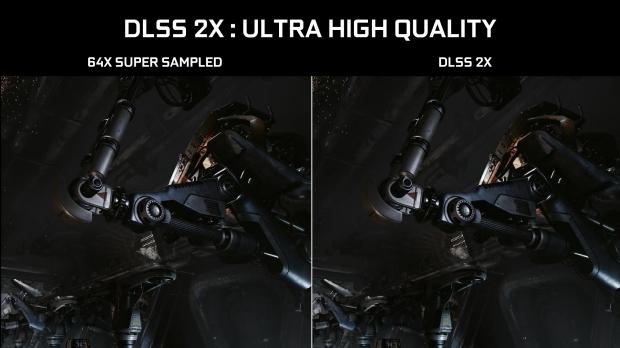
This is all under the standard DLSS mode but NVIDIA also has DLSS 2X which sees DLSS input being rendered at the final target resolution and then combined by an even bigger DLSS network that is capable of producing an output image that is close to the look of the 64x super-sampled rendering. NVIDIA notes that this would provide a result that would be "impossible to achieve in real-time by any traditional means".
DLSS Support - More On The Way
There are 15 games with DLSS support, and lots more of them on the way.
NGX Software Architecture
Another new thing inside of Turing is NGX or Neural Graphics Framework, which is where all of the AI models are created, stuffed into the driver and into your shiny new GeForce RTX graphics card.
NGX integration is easy: the AI model trains it, passes it through the neural network into the NGX API alongside the game engine, and into the rendered frame you see on your monitor.
We can expect some cool tricks from this, such as AI Super Rez that takes the image into the deep neural network and then blasts back a Super Res version of it. Imagine the possibilities with images, videos, and most of all gaming - powered by AI and DNNs.
AI To Power The Future Of Gaming
AI Will Eventually Be Better Than You At Games
When I was at the GeForce Gaming Celebration I talked to some NVIDIA staff about what the future of gaming would be like powered by the new AI abilities mixed with the Tensor Cores inside of Turing. The back-and-forth chat was beyond illuminating, really inspiring me that the future of gaming on PC will take things to the next level.
I was told about a game in the future would create scenarios where a player would advance on let's say, a military base with a few AI-based characters standing guard at the entrance. There's a button one of them would press in an emergency to alert the entire base of your presence, so you have multiple options to enter the base.
In this instance you are approaching the guards and want to take one down, so you crawl up the mountain slowly so that they don't see you. Remember, they don't have traditional vision and AI, but we're talking AI hardware that gives them almost individual personalities and human-like reactions to situations.
You pull out your sniper rifle and take out the guard on the left, an action that snaps the other soldiers mind and he panics. His friend has just been killed in front of him, so he looks at the body realistically (leaning over and checking on him) and as he turns to you, through the zoomed-in scope on your sniper rifle, you see his reaction.
The look of anger. The look of someone who has nothing going through their mind but ending your life. The AI would be powering a character in the game that would think like you. Does he begin cover firing and getting out of the way of your next shot, or does he shoot out the lights above him that allow you to see him?
AI will be smart enough to adapt to the situation at hand, so in this instance he shoots the light out above him descending your vision into darkness. The base has been alerted, the lights are out, and you don't have night vision. Your journey into the base just got 10x harder as you have AI that is beyond the levels we play with now, with human-like abilities and thought patterns.
The future of AI won't hide behind a wall waiting for you or running in circles, they're going to hunt you down in packs. You will be versing AI that is being driven by RT Cores and the Turing GPU architecture on NVIDIA's new GeForce RTX 2080/2080 Ti (and beyond) that is just as smart, and sometimes even better than good human gamers.
The fun with AI doesn't stop there, as we could see a total resurgence in all genres of games from the help of RT Cores, Deep Learning, and AI. Another genre would be horror. Imagine a next-gen reboot of the likes of Resident Evil or F.E.A.R. - because that's something I could get behind.
A new Left 4 Dead with the AI Director (that is already built in the game and tuning the game dynamically based on players' behavior and advancement in the game) being real AI driven by RT Cores. An AI that is dynamically adjusting the game with individual zombies and larger enemies (Smokers, Witches, etc) with much more powerful AI driving them at human-like levels.
Zombies could hunt you in packs, making them scarier and more dangerous than ever before. They could hunt you like animals using senses that they don't have now... imagine that RT Cores and AI could have them smelling you... yes, smelling you. This would make you have to think much more in the game about what exactly is attacking you, and how best to hide or run from it.
If you can't kill the zombie or animal tracking you, you might have to cover up your footprints through the dirt, sand, or mud. You will be forced to find water to jump into to mask your scent, or deal with a horde of AI-driven zombies that are smashing the house you're in to pieces at all different doors and windows confusing you to where they are and how you'll escape.
NVIDIA has provided the technology for the future of games, and now it's up to developers to tap the power of RT Cores in the Turing architecture. The only thing that I fear is that most games are multi-platform, so this would mean one of two things. First, we have normal games with additional RTX-specific AI features sprinkled on top of existing games and their pre-built AI.
Secondly, developers really tap into the RT Cores and AI power of Turing and make it part of the DNA of the game: truly next-gen AI that is similar to the stories that I heard in Germany at the GeForce Gaming Celebration event, or beyond. I want to sh*t my pants in a horror game that adapts to me... I want to have AI in shooters that is as good as a human opponent, I want to get smashed in RTS games against true AI.
The more exciting thing is that we're only scratching the possibilities of what could be the future of gaming powered by AI... it truly is limitless with NVIDIA's new Turing GPU architecture.
WTF IS RTX-OPS
NVIDIA Defines RTX-OPS
NVIDIA is so far ahead of AMD right now that it's in totally new territory with the Turing GPU architecture, so it has had to use its own "RTX-OPS" when trying to define performance of Tensor-related compute tasks. We won't be using RTX-OPS in our day-to-day benchmarks or RTX 20 series reviews, but it definitely deserves its own page to explain WTF is RTX-OPS.
The way NVIDIA works out RTX-OPS, the company explains that the "peak operations of each type based is derated on how often it's used". NVIDIA cites:
- Tensor operations are used 20% of the time
- CUDA cores are used 80% of the time
- RT cores are used 40% of the time (half of 80%)
- INT32 pipes are used 28% of the time (35% of 80%)
For example, RTX-OPS = TENSOR * 20% + FP32 * 80% + RTOPS * 40% + INT32 * 28%.
GPU Boost 4.0 & NVIDIA Scanner
NVIDIA has made the most overclockable GeForce graphics card yet with the new RTX 20 series, with the company openly embracing overclocking as a whole and making it easier than ever to overclock. We have the refreshed GPU Boost 4.0 technology and NVIDIA Scanner, software that will overclock your GPU for you... yeah, and it's not even powered by AI, yet.
GPU Boost 4.0
There have been changes made to GPU Boost technology with NVIDIA introducing GPU Boost 4.0 in the new Turing GPU architecture. GPU Boost 4.0 allows users to manually adjust the algorithms that GPU Boost uses to dial in the GPU clock. This gives users ultimate control over their new GPU, in more ways than one.
GPU Boost 3.0 launched with the Pascal GPU architecture and the GeForce GTX 1080 and GTX 1070 back in May 2017, where the Power Target sets the power limit for the GPU. The diagram above shows how the GPU clock is held back because the total power is already at that level, or lower.
If the power and temperature are below their intended targets, the GPU clock speeds won't hit a ceiling - but it's inevitable. If a typical boost GPU clock is hit and the temperature of the card starts climbing, GPU clocks get capped after the software capping temperature is reached. This all changes with GPU Boost 4.0 technology.
GPU Boost 4.0 takes overclocking to the next level by giving users access to the algorithms for GPU Boost itself, instead of them sitting inside of the driver with GPU Boost 3.0. NVIDIA says the biggest benefit with temperature on GPU Boost 4.0 is that where inflection points have been added.
Previously, the temperature was a straight line that dropped down next to Base Clock, but now it will holy the Boost Clock where you've overclocked it under higher temperatures before a second temp target (now T2) is hit, after which the GPU clocks will drop.
So. Awesome.
This means you can have additional performance from overclocking, and then if you spin the fans up on your GeForce RTX 20 series graphics card or have great airflow in your case, as long as you can keep the temperatures down. This should open up some doors for serious overclockers, with OC records surely reaching new heights with GeForce RTX 2080 Ti and GPU Boost 4.0 technology.
NVIDIA Scanner = Auto OC!
Automatic overclocking... it's here, right now with the new GeForce RTX series graphics cards. NVIDIA will have this technology inside of multiple AIB partners' software, with the company using EVGA's PrecisionX1 (which we had in early form for our review) and it works beautifully.
EVGA did a full re-design of their GPU management tool with PrecisionX1, where all of the inflection points in the Temp Tuner are editable, giving users full control of GPU Boost. We can expect new software to really push overclocking to the next level thanks to GPU Boost 4.0 and NVIDIA Scanner, where it will make it easier than ever for new users to overclock their graphics cards.
Overclocking your new RTX 20 series graphics card can take between 10-20 minutes to run, where it will launch a separate thread to test overclocking on the GPU. It will run a mathematical algorithm that tries to find single- and multi-bit failures so it can provide 100% stability at OC speeds. You can start the NVIDIA Scanner and stop it mid way through it you wanted to play a game, and then resume your overclocking adventures afterwards, too.
The power and temperature sliders have much more control over your maximum GPU clocks than ever before, so be sure to play around with them for maximum OC. I pushed my RTX 2080 Ti FE sample up to 2GHz at the 65-68C range with 100% fan speeds, +123 power and the GPU temps allowed to hit 88C. Not bad for the first few hours of playing with it.
Test System Specs
Our New GPU Test Rig
Welcome to the latest revision of our GPU test bed, with our system being upgraded from the Intel Core i7-7700K to the Core i7-8700K. The CPU is cooled by the Corsair H115i PRO cooler, with the 8700K overclocked to 5GHz. We've stayed with GIGABYTE for our motherboard with their awesome Z370 AORUS Gaming 7.
We approached our friends at HyperX for a kit of their kick ass HyperX Predator DDR4-2933MHz RAM (HX429C15PB3AK4/32), with 2 x 8GB sticks for a total of 16GB DDR4-2933. The RAM stands out through every minute of our testing as it has beautiful RGB lights giving the system a slick look while benchmarking our lives away, while the Z370 AORUS Gaming 7 motherboard joins in with its own array of RGB lighting.
Detailed Tech Specs
- CPU: Intel Core i7-8700K @ 5GHz
- Cooler: Corsair Hydro Series H115i PRO
- MB: Z370 AORUS Gaming 7
- RAM: 16GB (2x8GB) HyperX Predator DDR4-2933
- SSD: 1TB OCZ RD400 NVMe M.2
- SSD: 512GB OCZ RD400 NVMe M.2
- PSU: InWin 1065W PSU
- Chassis: In Win X-Frame
- OS: Windows 10 Pro x64
Additional Images
Benchmarks - Synthetic
3DMark Fire Strike - 1080p
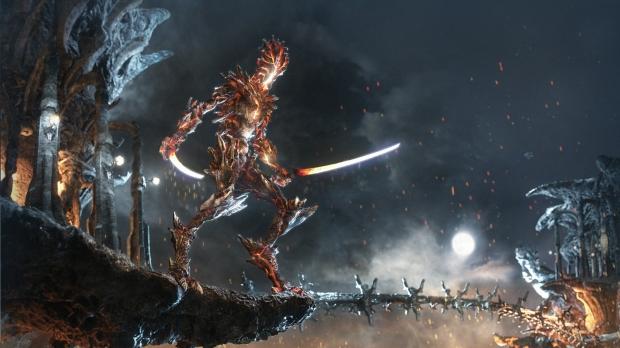
3DMark has been a staple benchmark for years now, all the way back to when The Matrix was released and Futuremark had bullet time inspired benchmarks. 3DMark is the perfect tool to see if your system - most important, your CPU and GPU - is performing as it should. You can search results for your GPU, to see if it falls in line with other systems based on similar hardware.
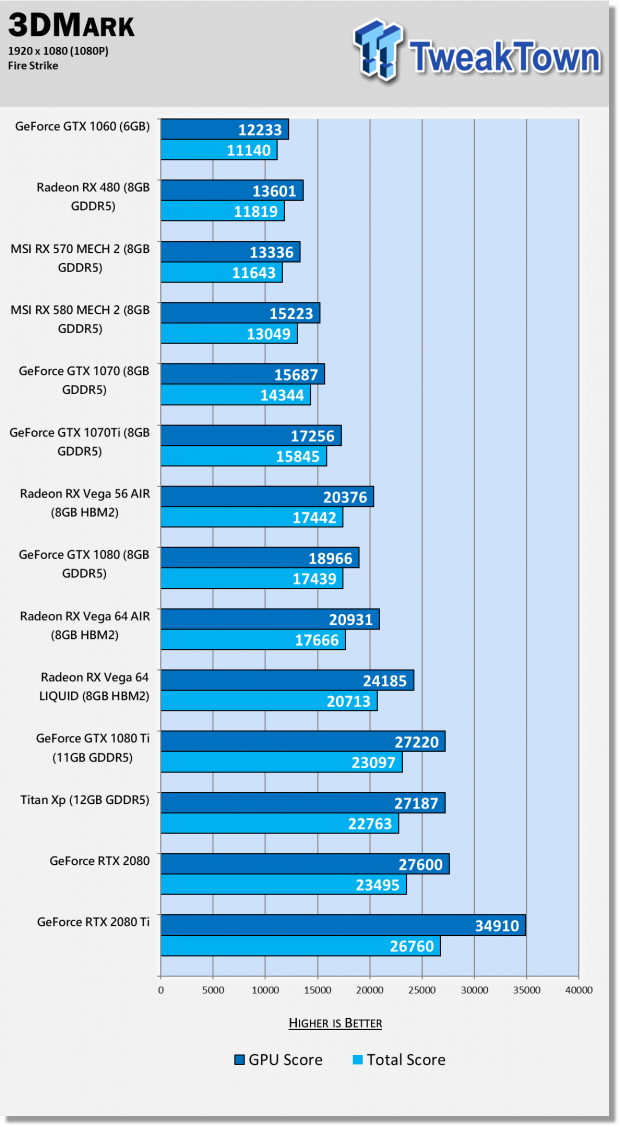
3DMark Fire Strike - 1440p
3DMark has been a staple benchmark for years now, all the way back to when The Matrix was released and Futuremark had bullet time inspired benchmarks. 3DMark is the perfect tool to see if your system - most important, your CPU and GPU - is performing as it should. You can search results for your GPU, to see if it falls in line with other systems based on similar hardware.
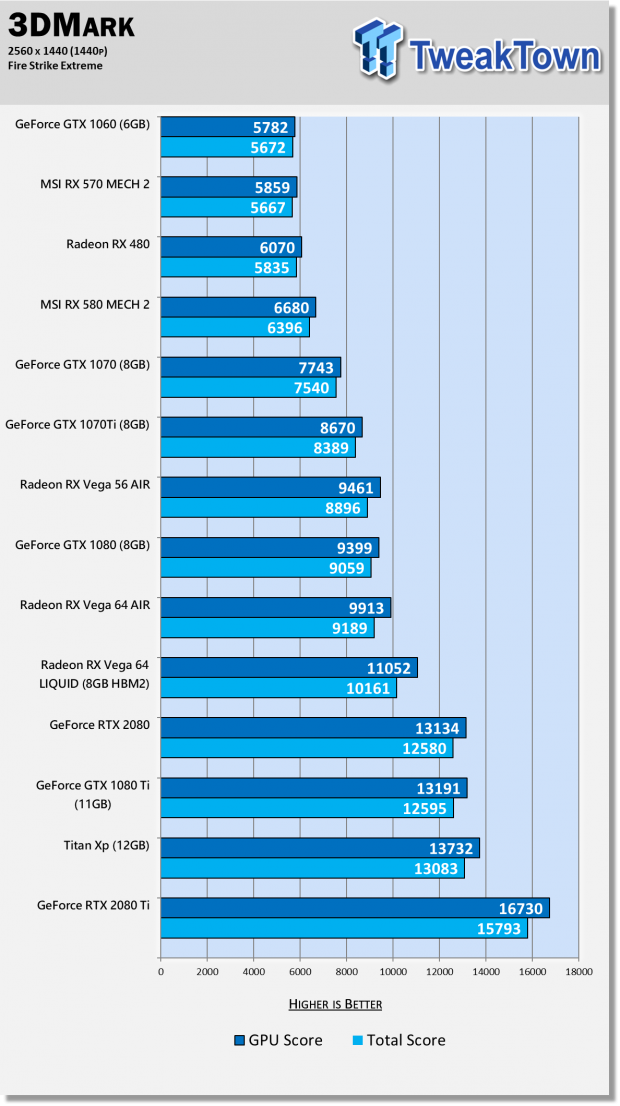
3DMark Fire Strike - 4K
3DMark has been a staple benchmark for years now, all the way back to when The Matrix was released and Futuremark had bullet time inspired benchmarks. 3DMark is the perfect tool to see if your system - most important, your CPU and GPU - is performing as it should. You can search results for your GPU, to see if it falls in line with other systems based on similar hardware.
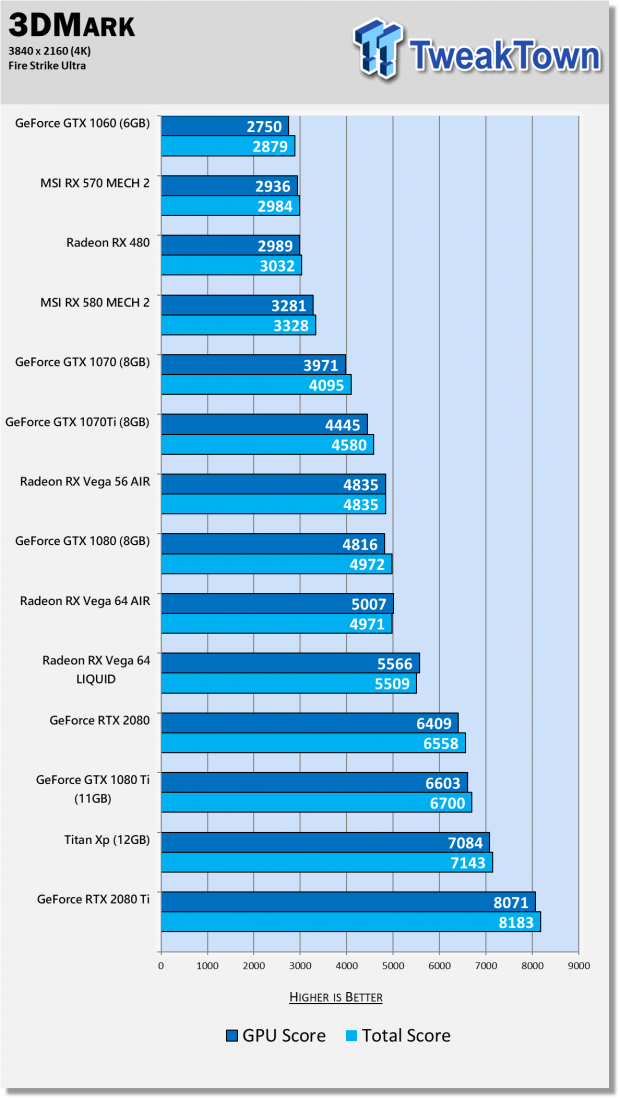
3DMark TimeSpy

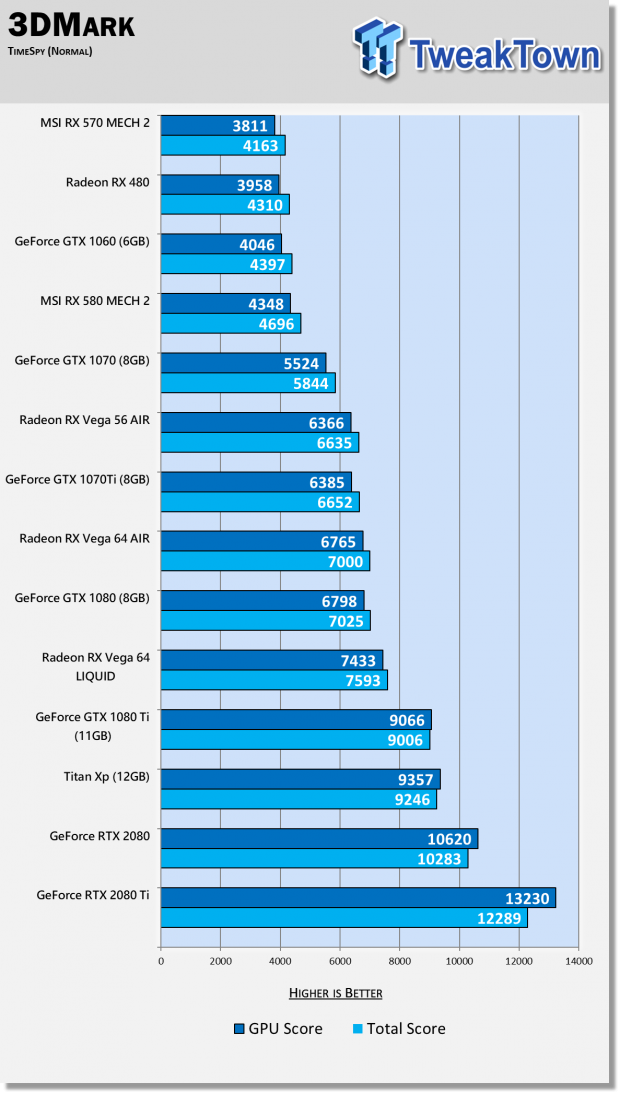
3DMark TimeSpy Extreme
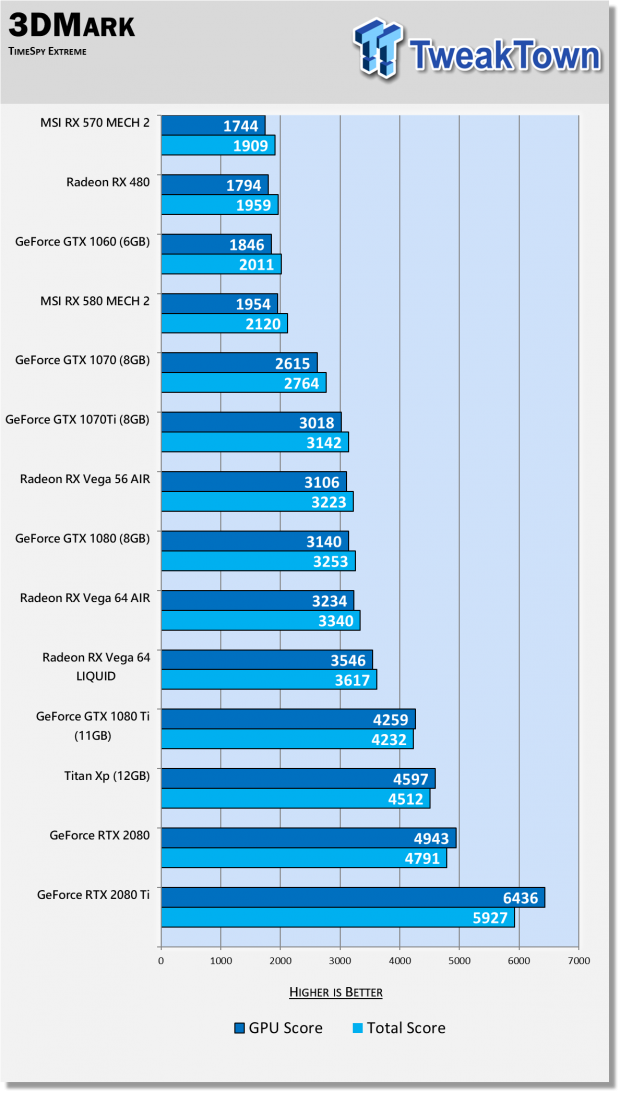
Heaven - 1080p
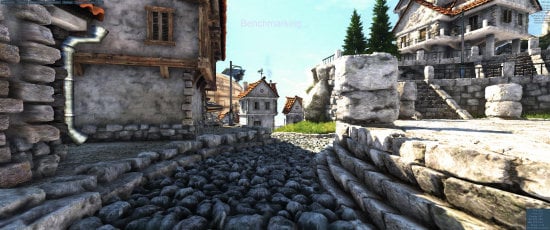
Heaven is an intensive GPU benchmark that really pushes your silicon to its limits. It's another favorite of ours as it has some great scaling for multi-GPU testing, and it's great for getting your GPU to 100% for power and noise testing.
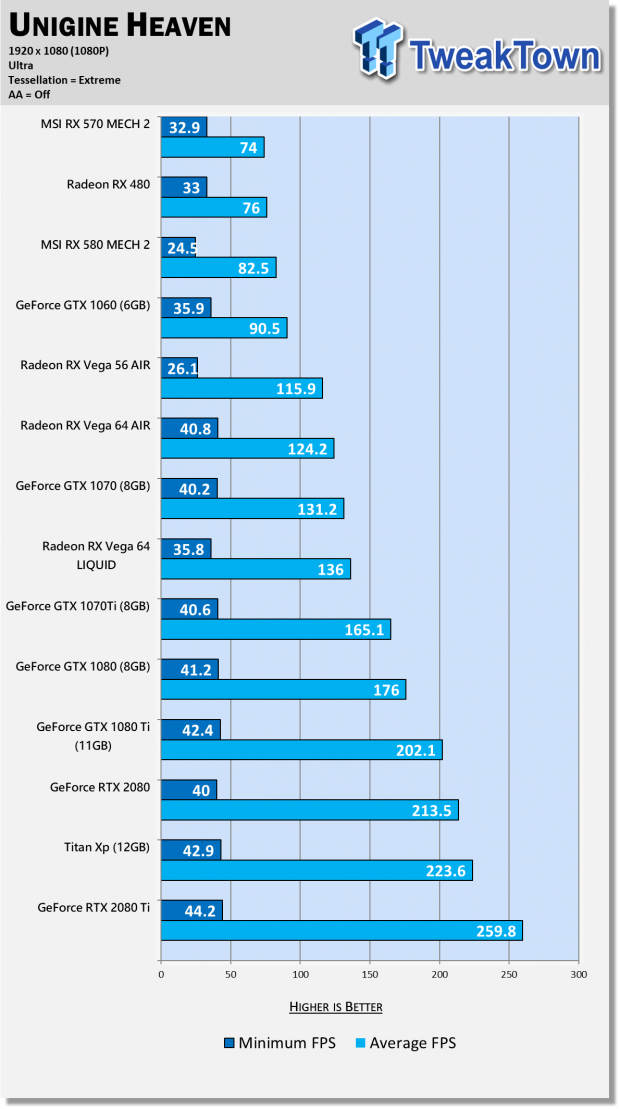
Heaven - 1440p
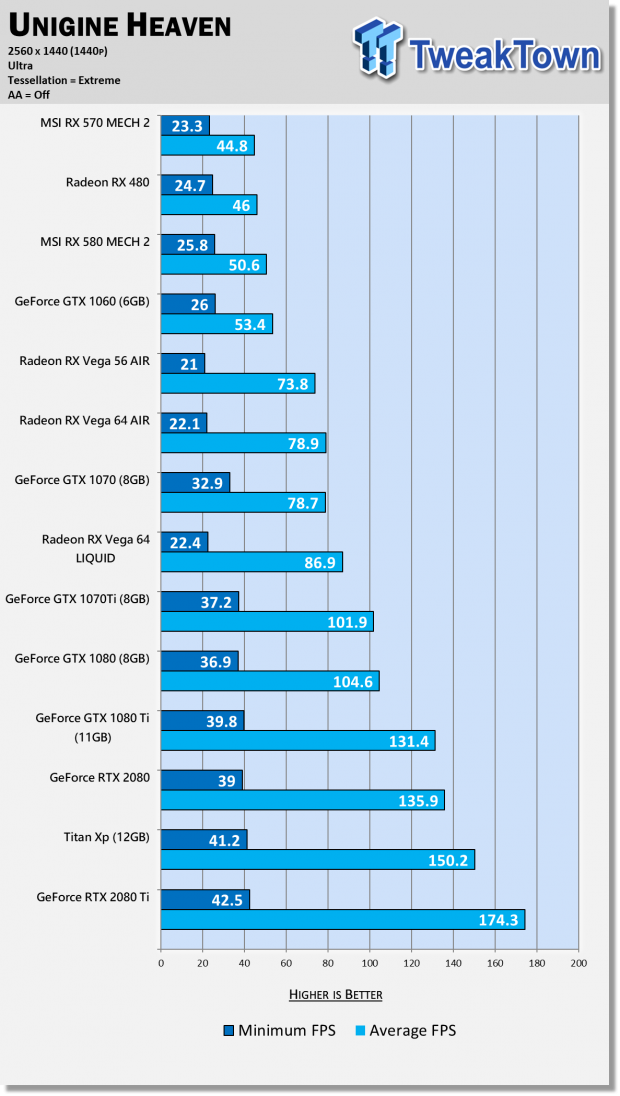
Heaven - 4K
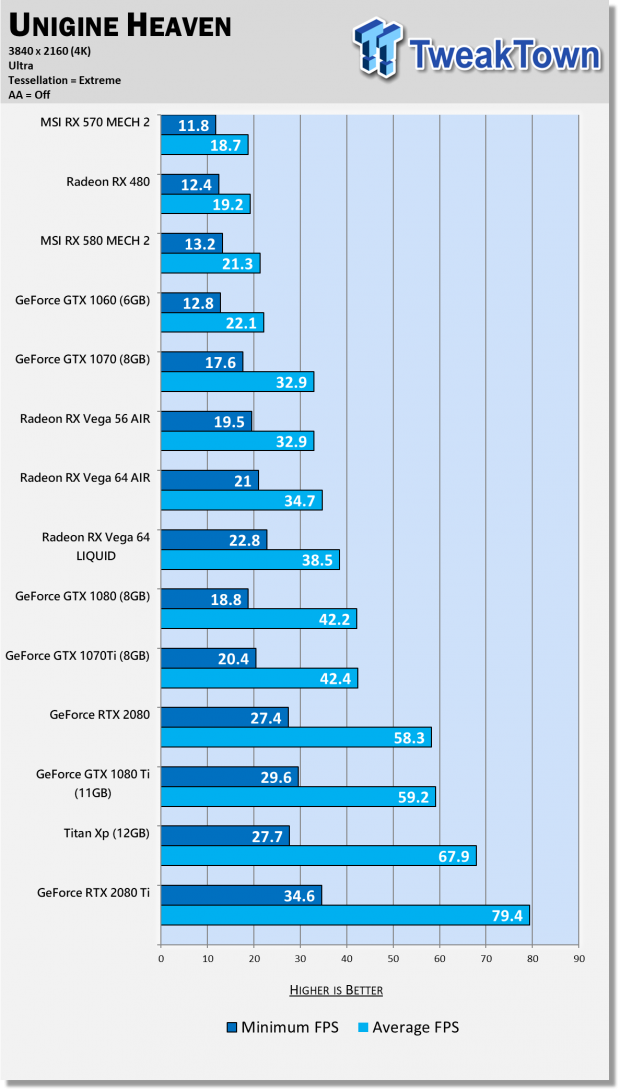
Heaven - 3440x1440
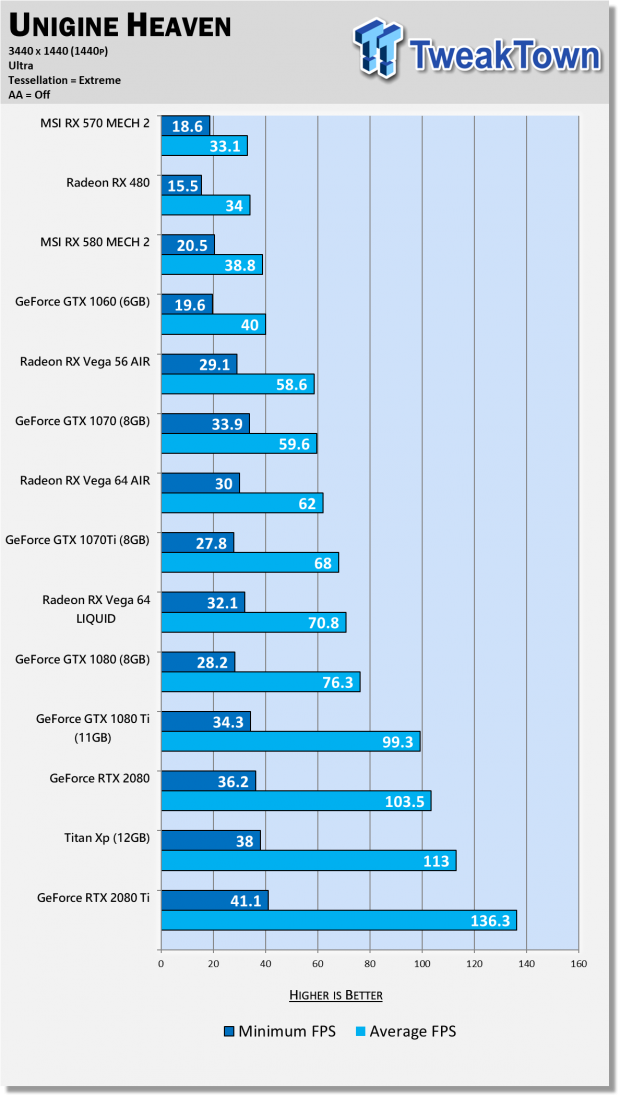
Benchmarks - 1080p
1080p Benchmarks
Rise of the Tomb Raider is one of the best looking games on the market, a truly gorgeous game - and a wonder to benchmark. The team at Crystal Dynamics made a very scalable PC game that plays really well testing graphics cards. We've got DX11 and DX12 results in one here, showing the slight strengths of running DX12 mode.
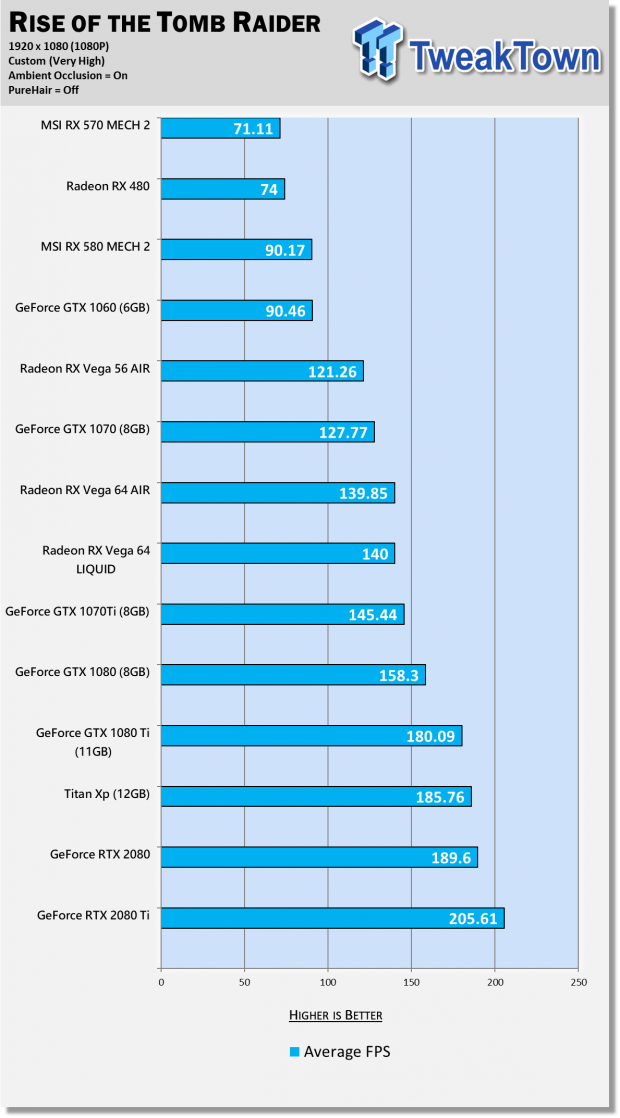
Middle-earth: Shadow of War is a sequel to the popular Shadow of Mordor, which was powered by the Lithtech engine. When cranked up to maximum detail, it will chew through your GPU and its VRAM like it's nothing.
You can buy Middle-earth: Shadow of War at Amazon.
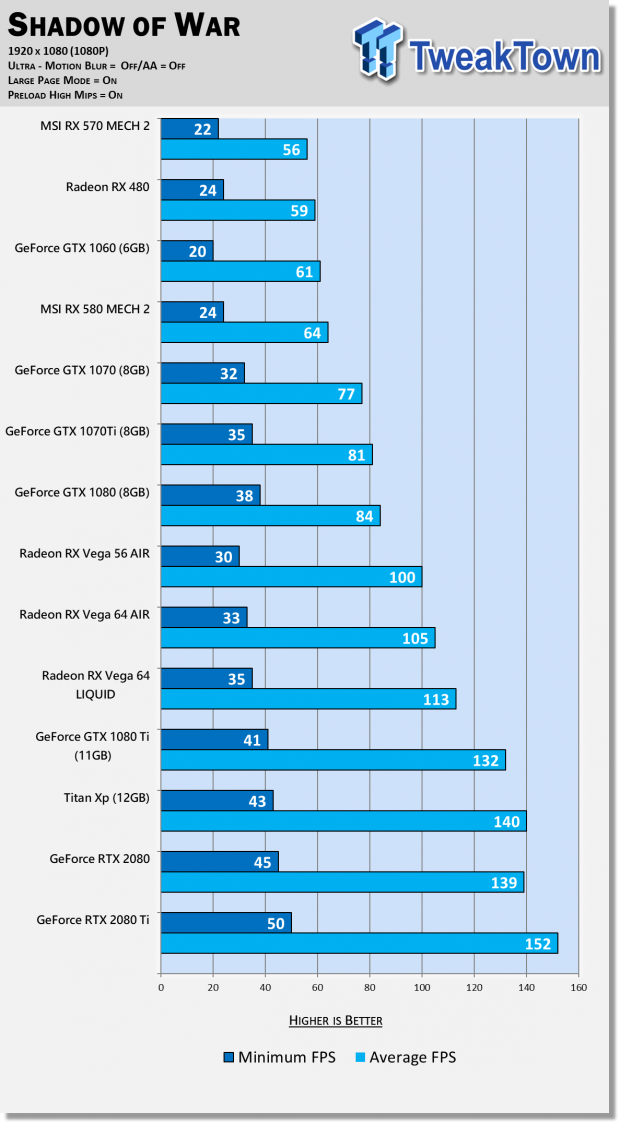
Rainbow Six: Siege has been a strong entry into the franchise, popular for its realistic feel and great graphics. Stable as a rock for benchmarking, right up to 3440x1440 and 4K.
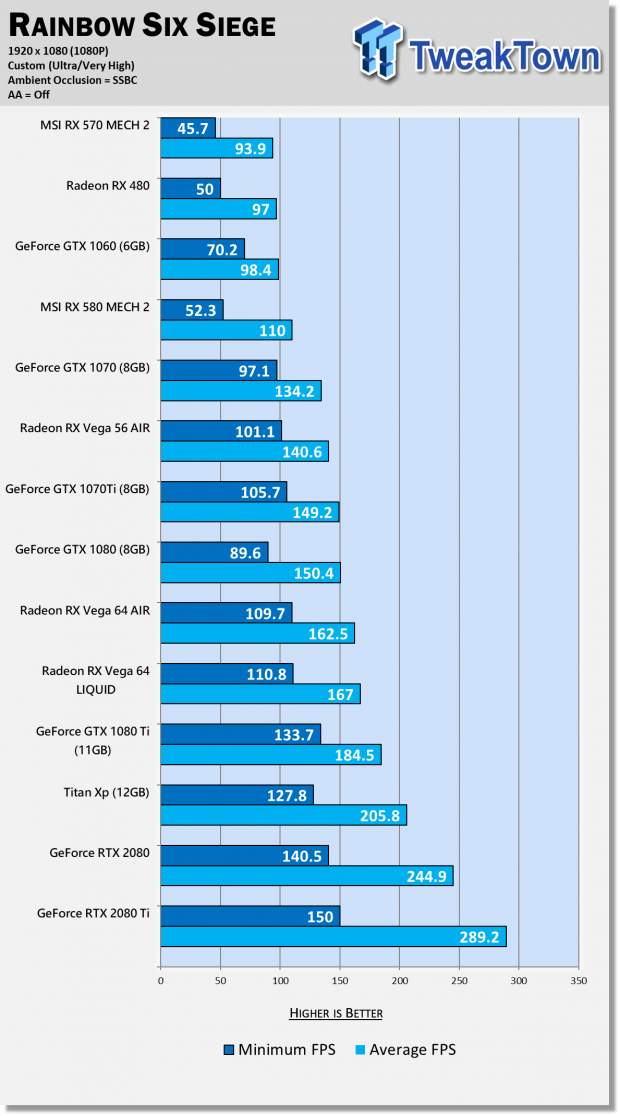
Metro: Last Light Redux comes from developer 4A Games, making the Redux version of Metro: Last Light the 'definitive' version of the game. Redux had a fresh coat of paint on the already impressive 4A Engine, and it really pushes our GPUs to their limits.
You can buy Metro: Last Light Redux at Amazon.
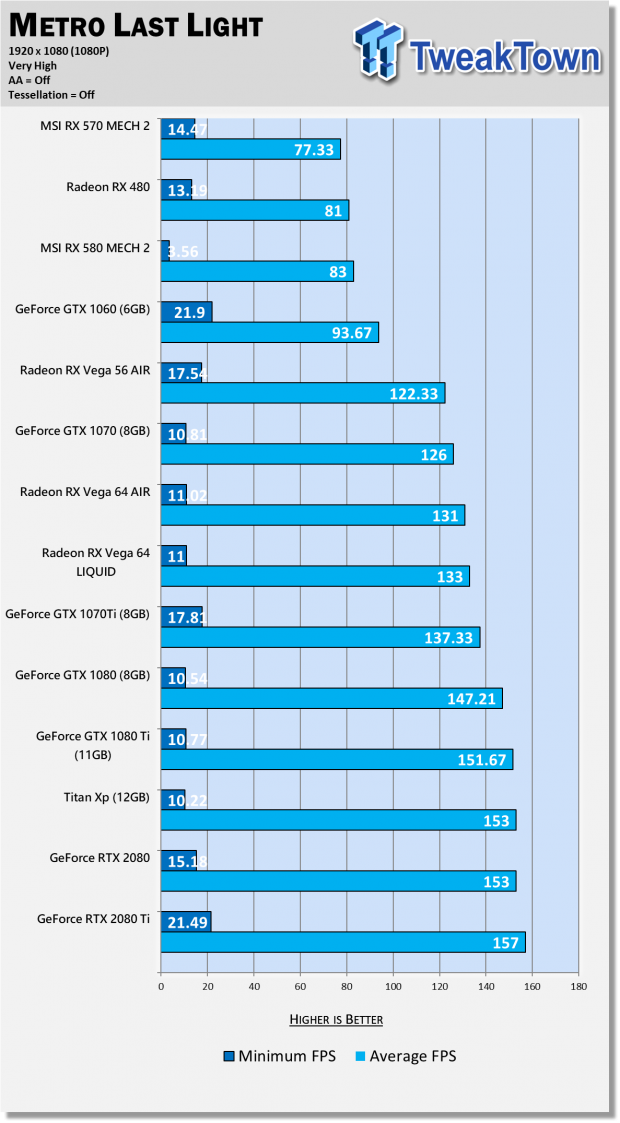
Far Cry 5 was developed by Ubisoft, and is powered the Dunia Engine, an engine that has been modified over the years for Far Cry. Dunia Engine itself was a modified version of CRYENGINE, scaling incredibly well on all sorts of hardware.
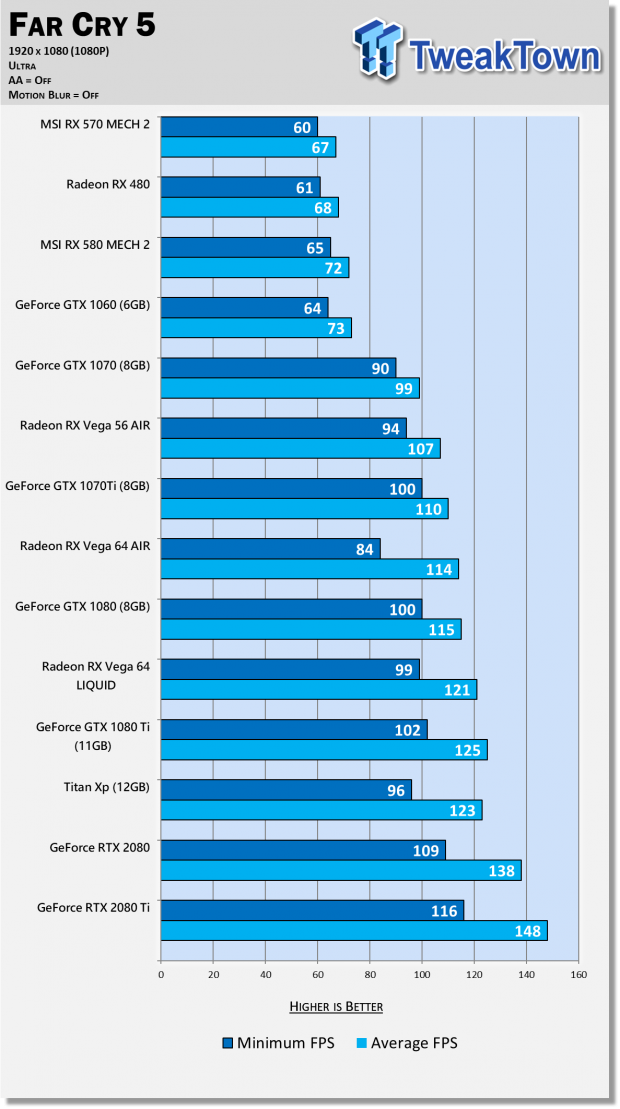
F1 2018 is the latest iteration of the super-popular franchise that Codemasters has worked on for close to a decade now, with F1 2009 kicking it all off. The game is powered by the EGO game engine, which is a modified version of the Neon game engine that was developed by Codemasters and Sony Computer Entertainment for Colin McRae: Dirt, which was released in 2007. The revamped EGO engine was developed to give Codemasters the ability of using more detailed damage and physics in the game world, as well as rendering larger-scale environments.
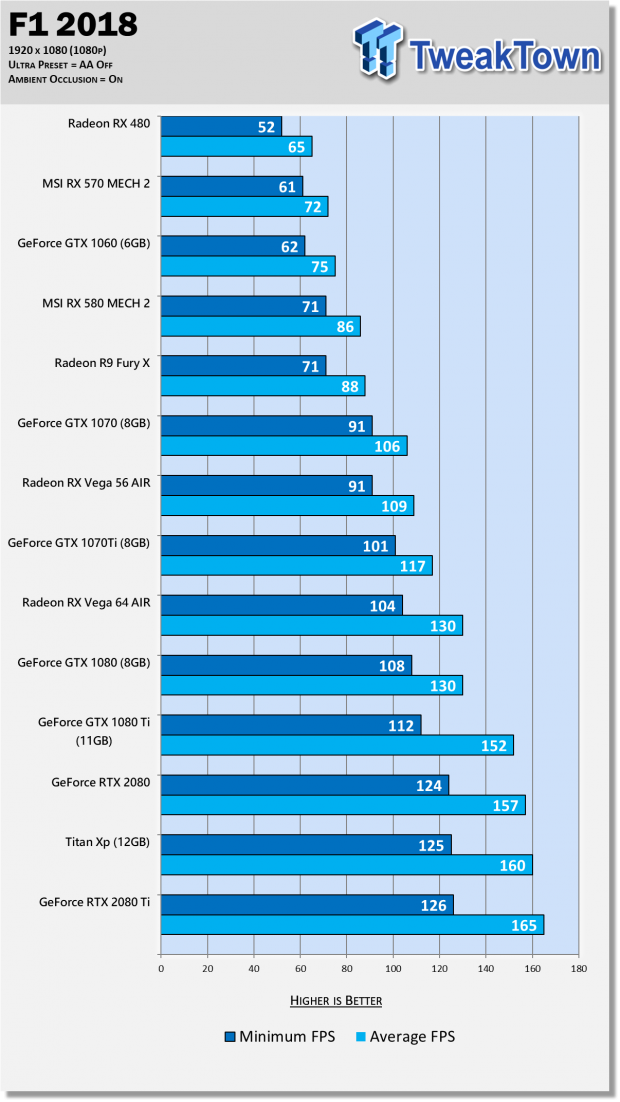
Shadow of the Tomb Raider is one of the latest games to join our graphics card benchmark lineup, with the game built using the Foundation engine as a base, the same engine in Rise of the Tomb Raider. Eidos Montreal R&D department made lots of changes to the engine during the development of Shadow of the Tomb Raider to make it one of the best-looking games out right now.
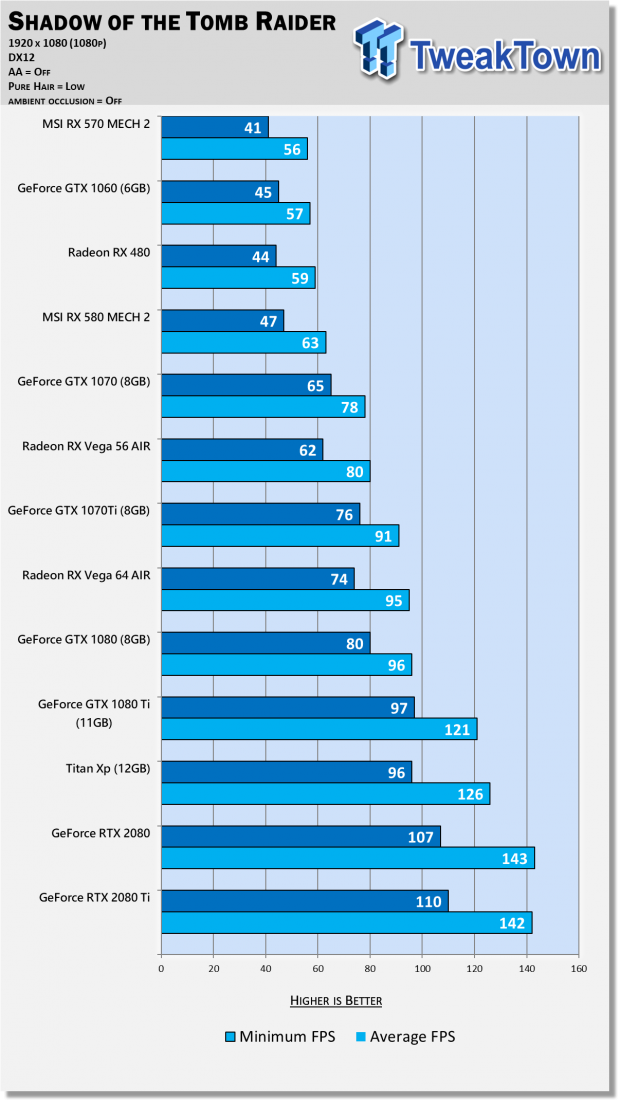
Benchmarks - 1440p
1440p Benchmarks
Rise of the Tomb Raider is one of the best looking games on the market, a truly gorgeous game - and a wonder to benchmark. The team at Crystal Dynamics made a very scalable PC game that plays really well testing graphics cards. We've got DX11 and DX12 results in one here, showing the slight strengths of running DX12 mode.
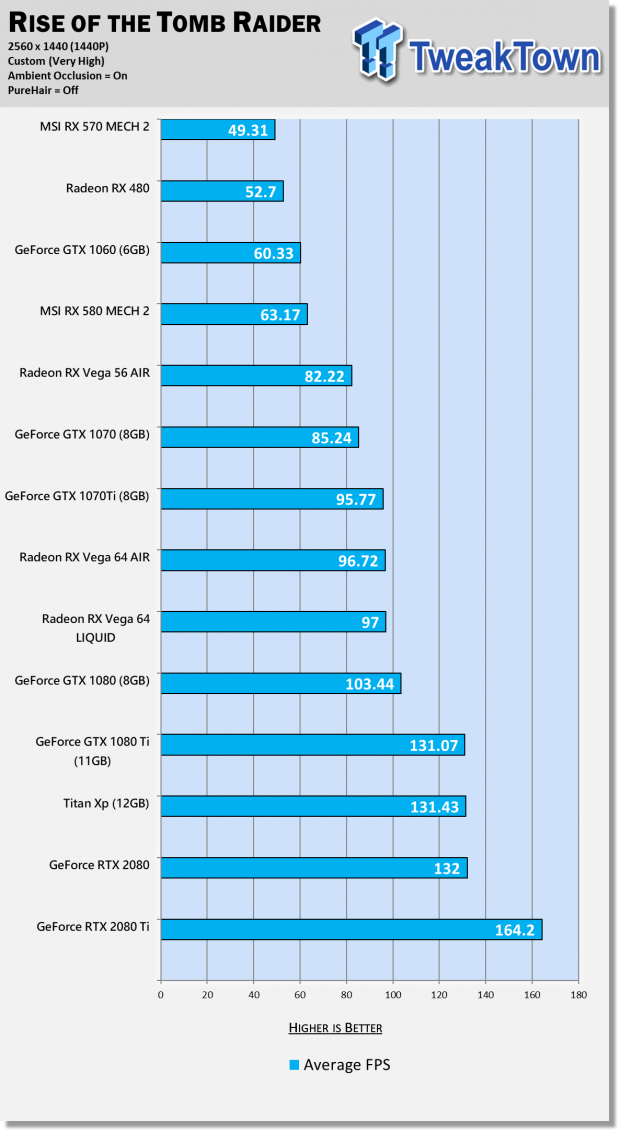
Middle-earth: Shadow of War is a sequel to the popular Shadow of Mordor, which was powered by the Lithtech engine. When cranked up to maximum detail, it will chew through your GPU and its VRAM like it's nothing.
You can buy Middle-earth: Shadow of War at Amazon.
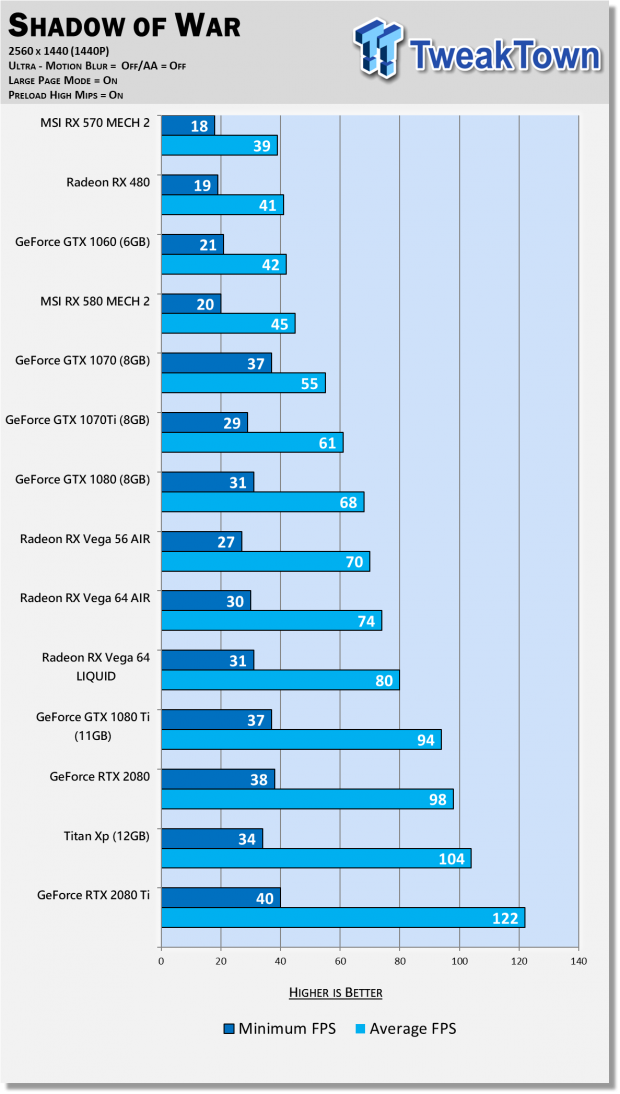
Rainbow Six: Siege has been a strong entry into the franchise, popular for its realistic feel and great graphics. Stable as a rock for benchmarking, right up to 3440x1440 and 4K.
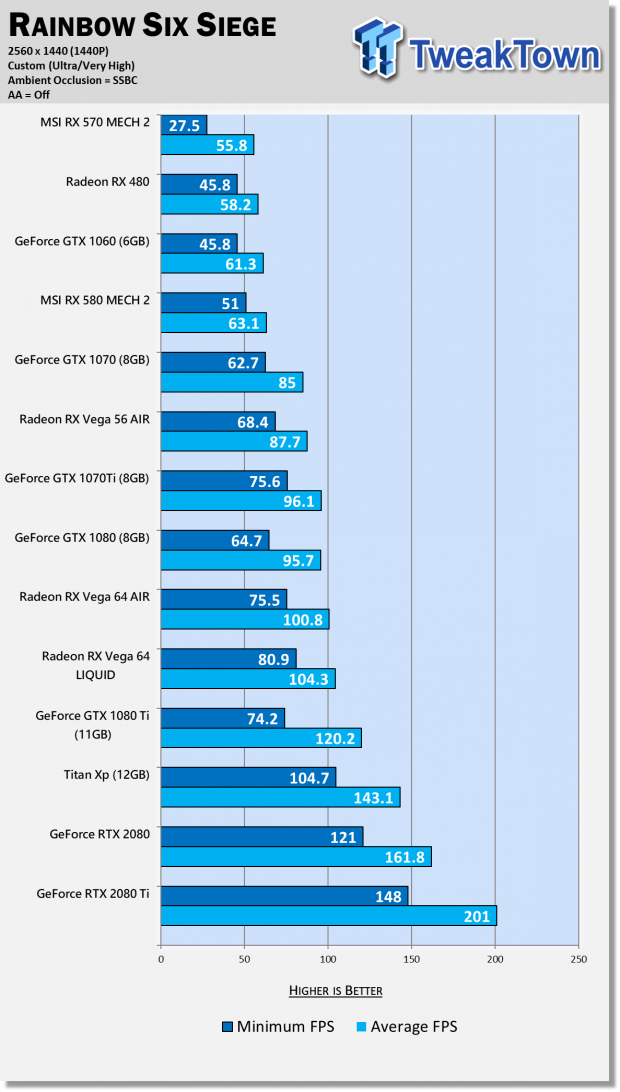
Metro: Last Light Redux comes from developer 4A Games, making the Redux version of Metro: Last Light the 'definitive' version of the game. Redux had a fresh coat of paint on the already impressive 4A Engine, and it really pushes our GPUs to their limits.
You can buy Metro: Last Light Redux at Amazon.
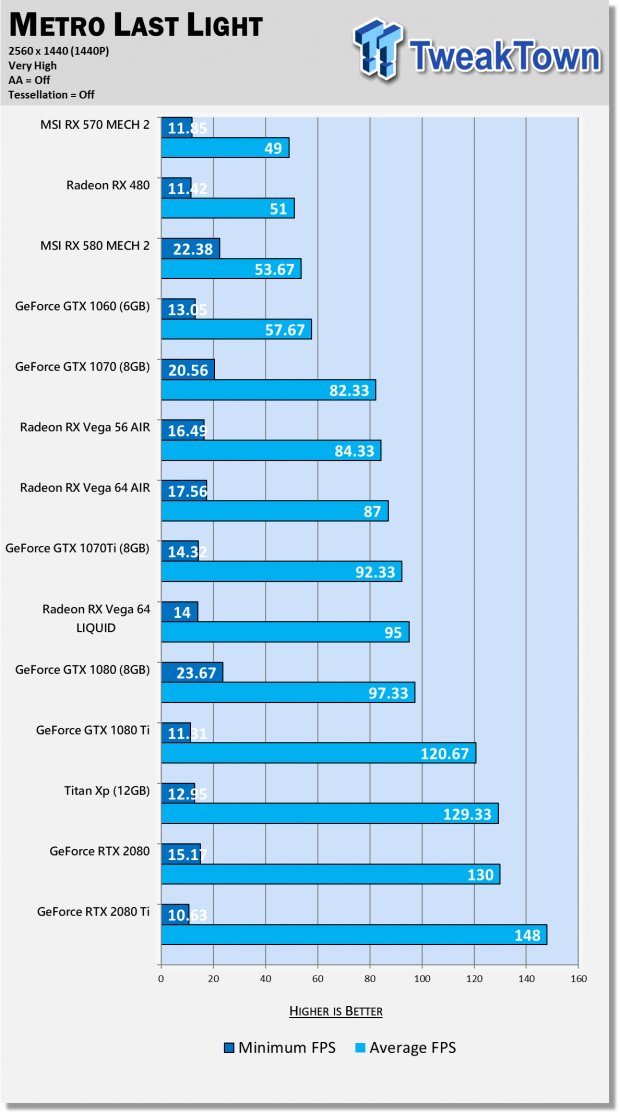
Far Cry 5 was developed by Ubisoft, and is powered the Dunia Engine, an engine that has been modified over the years for Far Cry. Dunia Engine itself was a modified version of CRYENGINE, scaling incredibly well on all sorts of hardware.
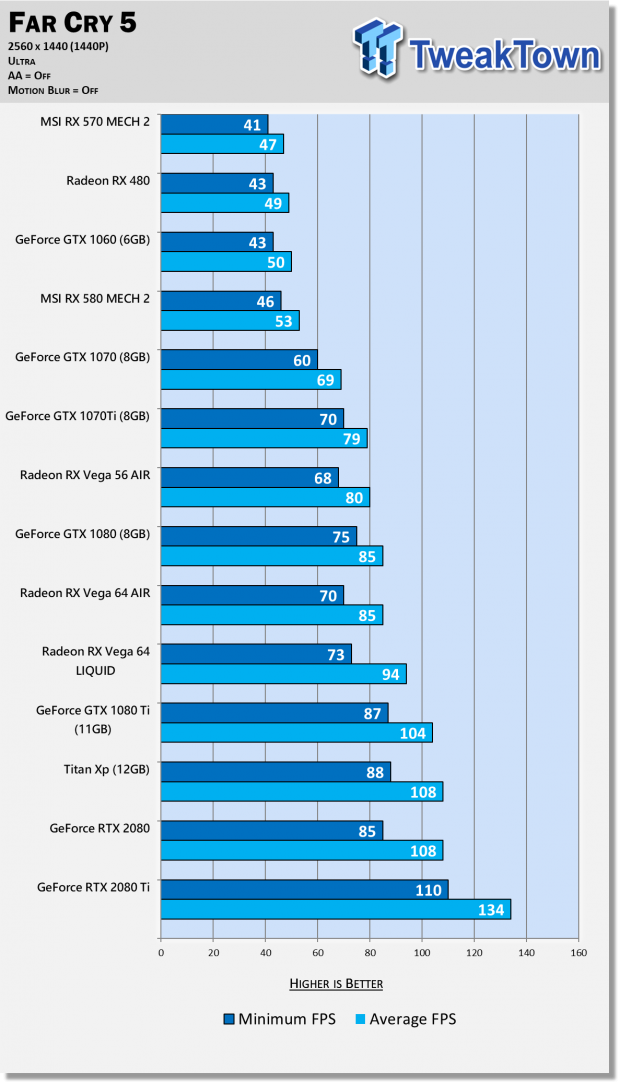
F1 2018 is the latest iteration of the super-popular franchise that Codemasters has worked on for close to a decade now, with F1 2009 kicking it all off. The game is powered by the EGO game engine, which is a modified version of the Neon game engine that was developed by Codemasters and Sony Computer Entertainment for Colin McRae: Dirt, which was released in 2007. The revamped EGO engine was developed to give Codemasters the ability of using more detailed damage and physics in the game world, as well as rendering larger-scale environments.
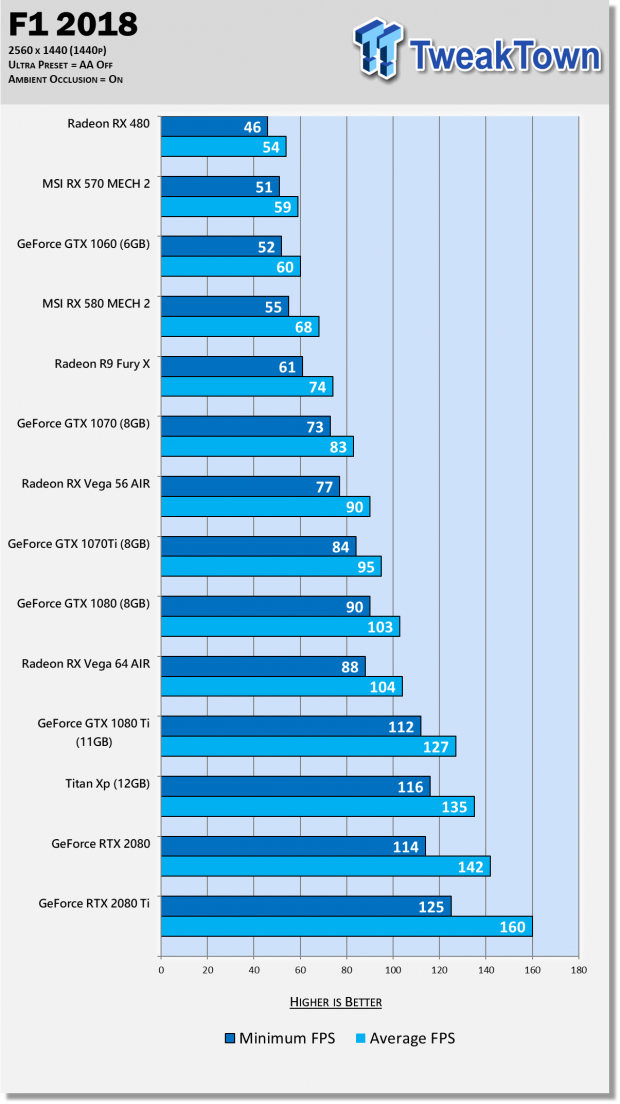
Shadow of the Tomb Raider is one of the latest games to join our graphics card benchmark lineup, with the game built using the Foundation engine as a base, the same engine in Rise of the Tomb Raider. Eidos Montreal R&D department made lots of changes to the engine during the development of Shadow of the Tomb Raider to make it one of the best-looking games out right now.
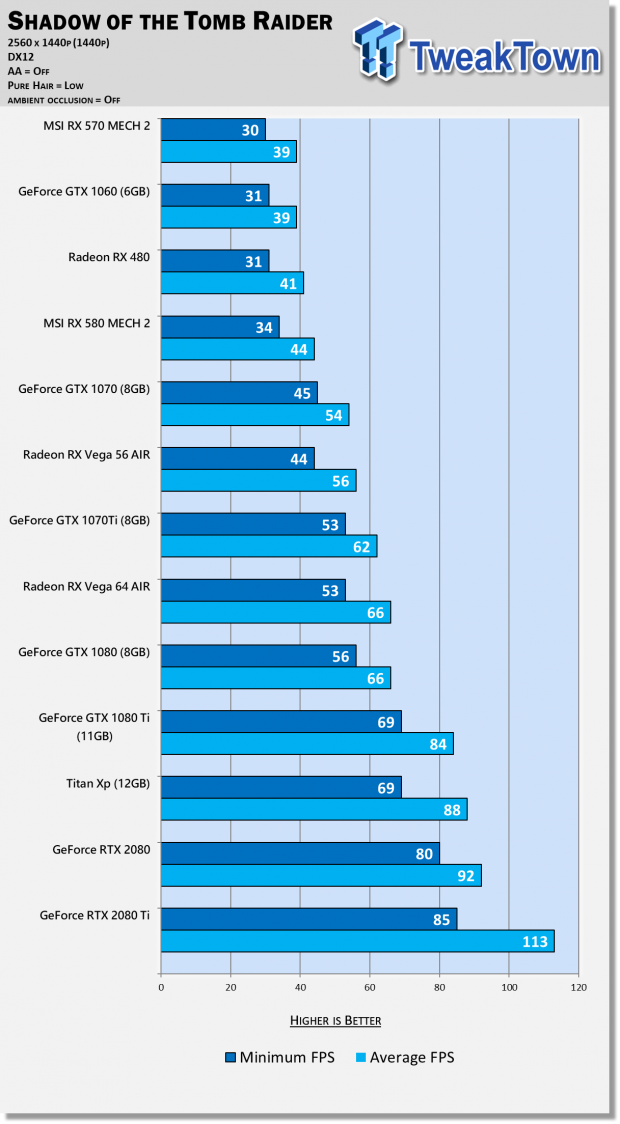
Benchmarks - 3440x1440
3440 x 1440 Benchmarks
Rise of the Tomb Raider is one of the best looking games on the market, a truly gorgeous game - and a wonder to benchmark. The team at Crystal Dynamics made a very scalable PC game that plays really well testing graphics cards. We've got DX11 and DX12 results in one here, showing the slight strengths of running DX12 mode.
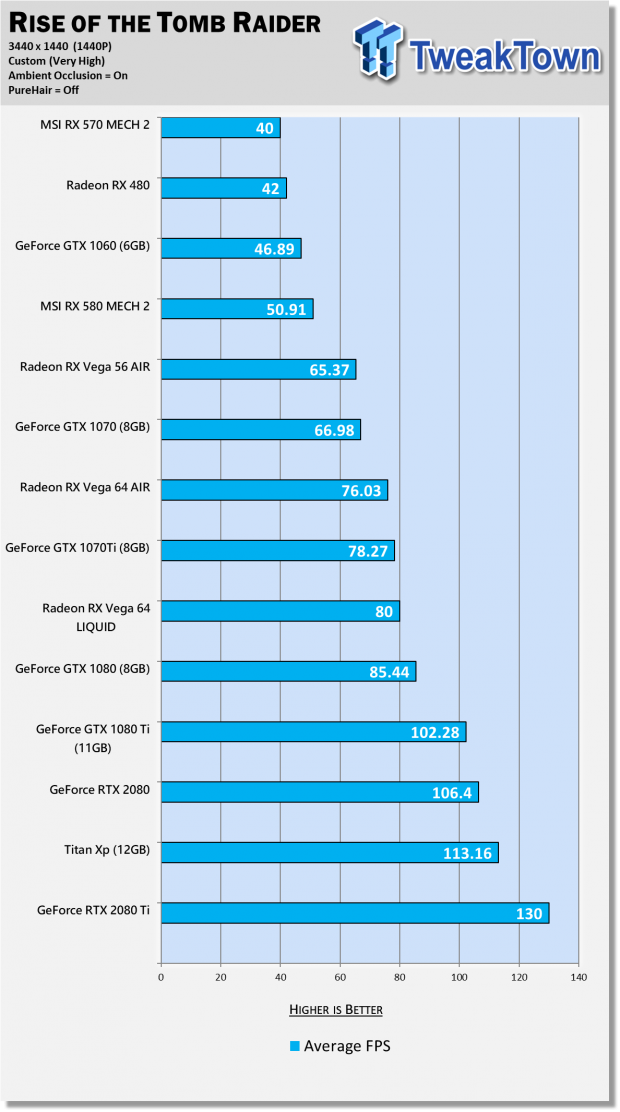
Middle-earth: Shadow of War is a sequel to the popular Shadow of Mordor, which was powered by the Lithtech engine. When cranked up to maximum detail, it will chew through your GPU and its VRAM like it's nothing.
You can buy Middle-earth: Shadow of War at Amazon.
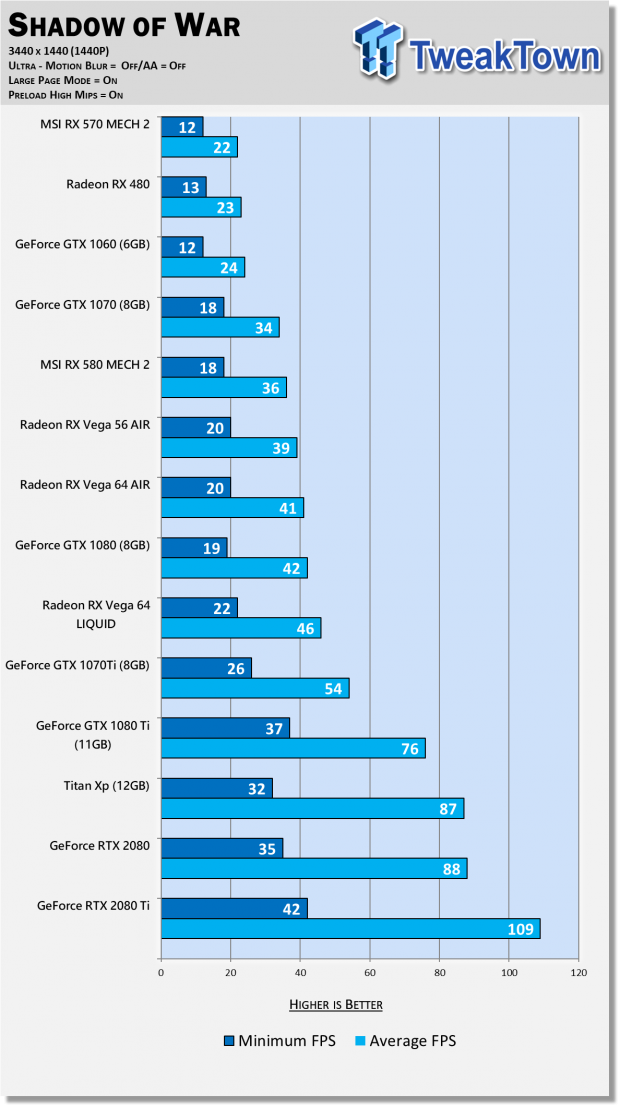
Rainbow Six: Siege has been a strong entry into the franchise, popular for its realistic feel and great graphics. Stable as a rock for benchmarking, right up to 3440x1440 and 4K.
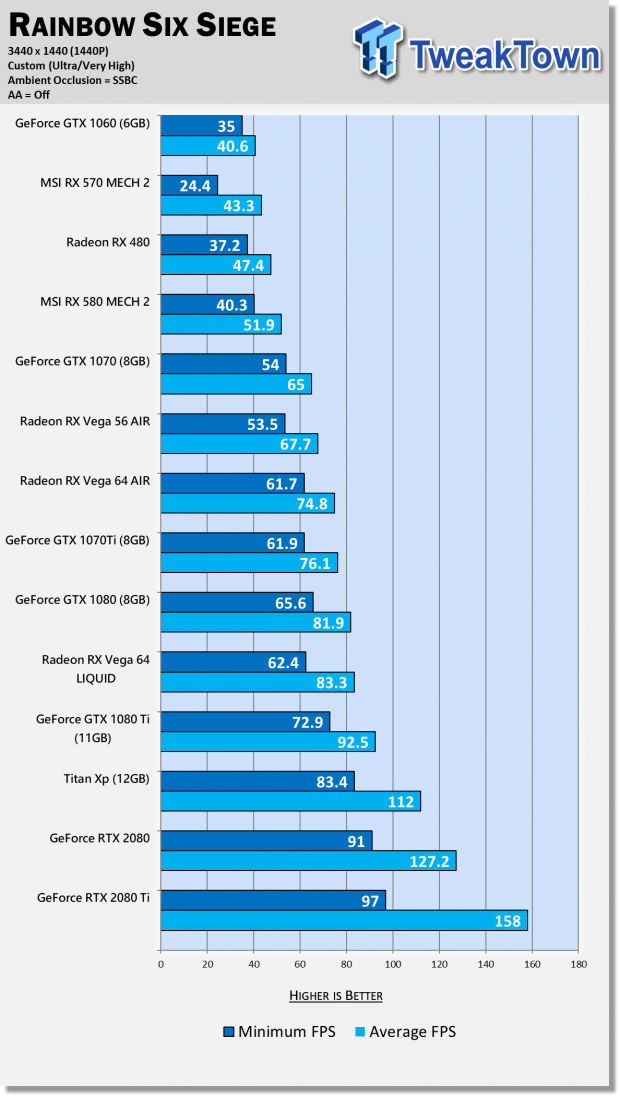
Metro: Last Light Redux comes from developer 4A Games, making the Redux version of Metro: Last Light the 'definitive' version of the game. Redux had a fresh coat of paint on the already impressive 4A Engine, and it really pushes our GPUs to their limits.
You can buy Metro: Last Light Redux at Amazon.
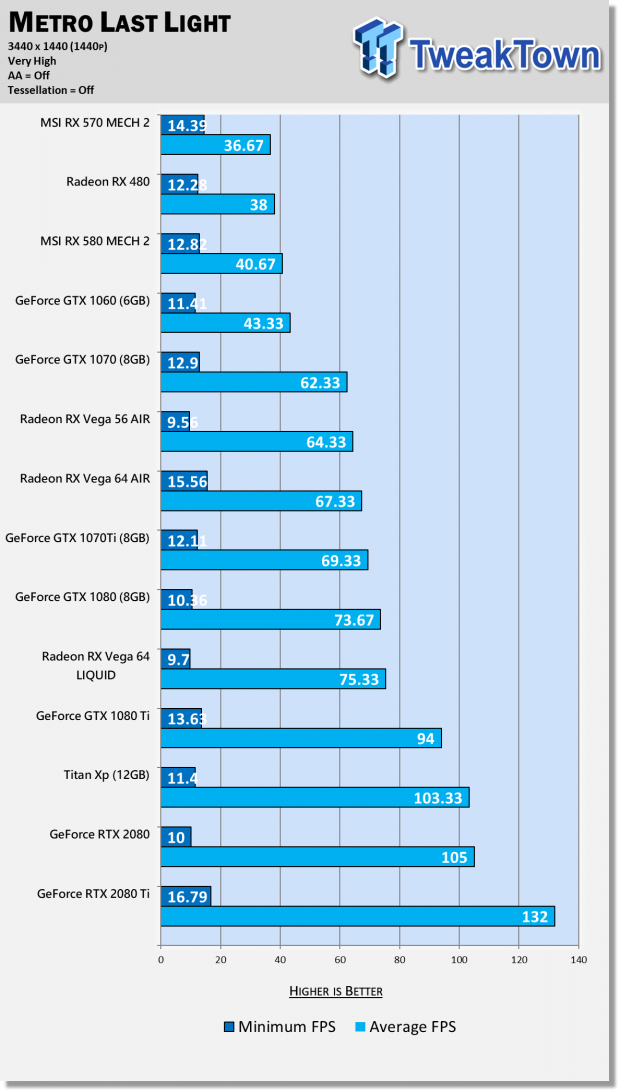
Far Cry 5 was developed by Ubisoft, and is powered the Dunia Engine, an engine that has been modified over the years for Far Cry. Dunia Engine itself was a modified version of CRYENGINE, scaling incredibly well on all sorts of hardware.
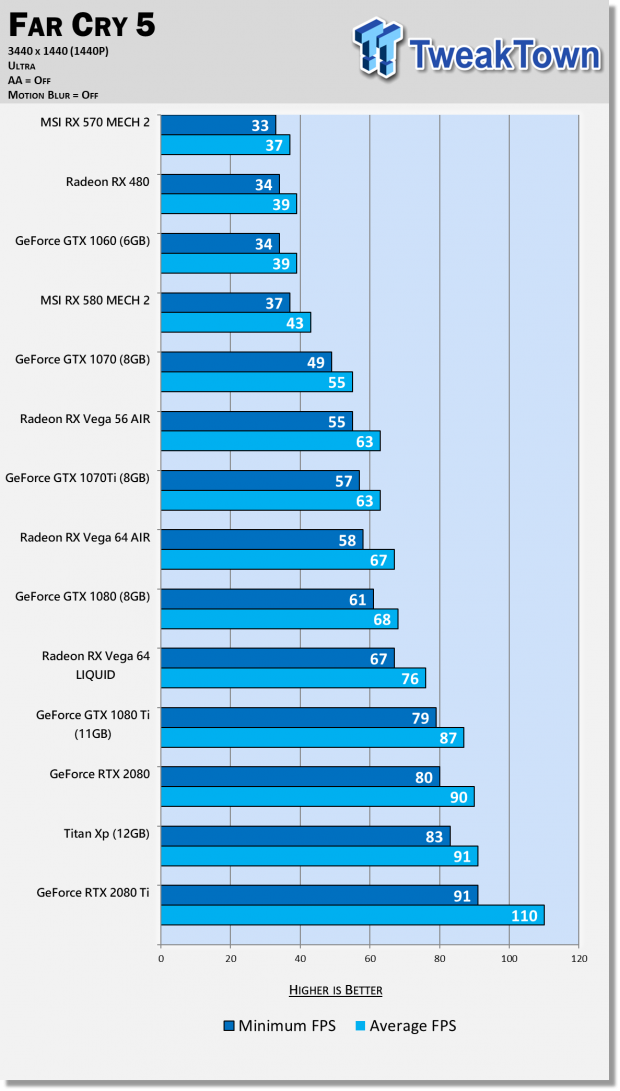
F1 2018 is the latest iteration of the super-popular franchise that Codemasters has worked on for close to a decade now, with F1 2009 kicking it all off. The game is powered by the EGO game engine, which is a modified version of the Neon game engine that was developed by Codemasters and Sony Computer Entertainment for Colin McRae: Dirt, which was released in 2007. The revamped EGO engine was developed to give Codemasters the ability of using more detailed damage and physics in the game world, as well as rendering larger-scale environments.
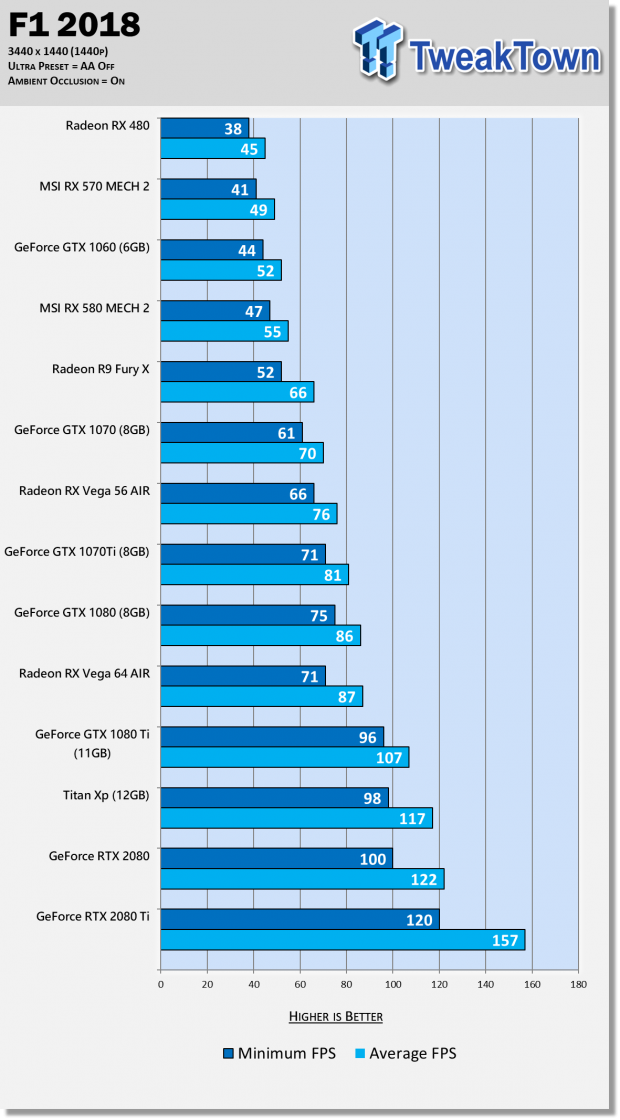
Shadow of the Tomb Raider is one of the latest games to join our graphics card benchmark lineup, with the game built using the Foundation engine as a base, the same engine in Rise of the Tomb Raider. Eidos Montreal R&D department made lots of changes to the engine during the development of Shadow of the Tomb Raider to make it one of the best-looking games out right now.
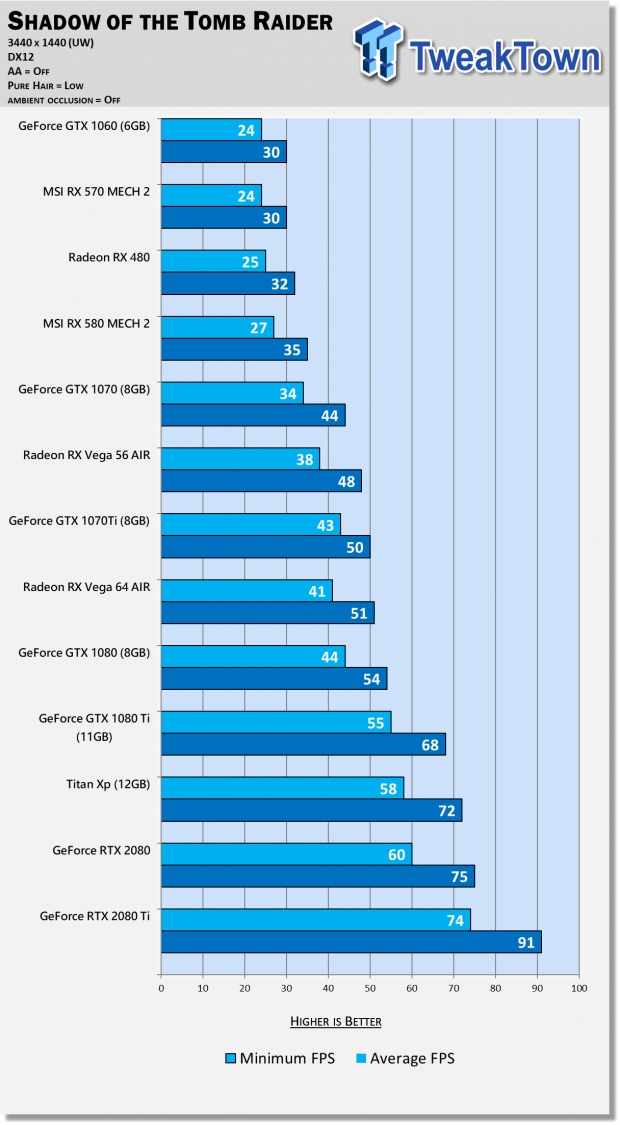
Benchmarks - 4K
4K Benchmarks
Rise of the Tomb Raider is one of the best looking games on the market, a truly gorgeous game - and a wonder to benchmark. The team at Crystal Dynamics made a very scalable PC game that plays really well testing graphics cards. We've got DX11 and DX12 results in one here, showing the slight strengths of running DX12 mode.
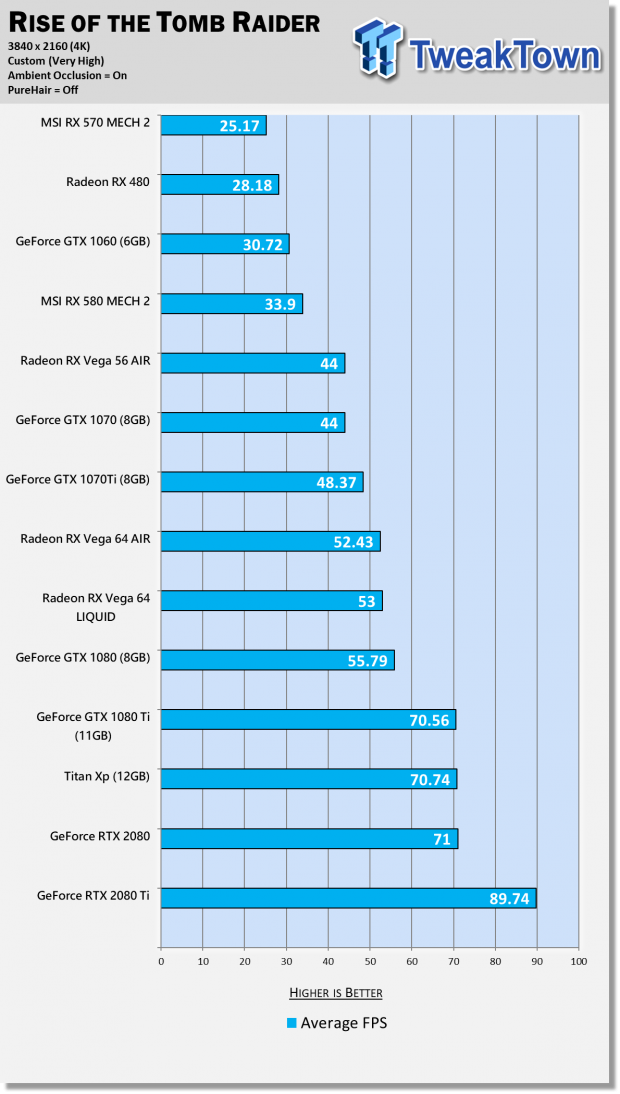
Middle-earth: Shadow of War is a sequel to the popular Shadow of Mordor, which was powered by the Lithtech engine. When cranked up to maximum detail, it will chew through your GPU and its VRAM like it's nothing.
You can buy Middle-earth: Shadow of War at Amazon.
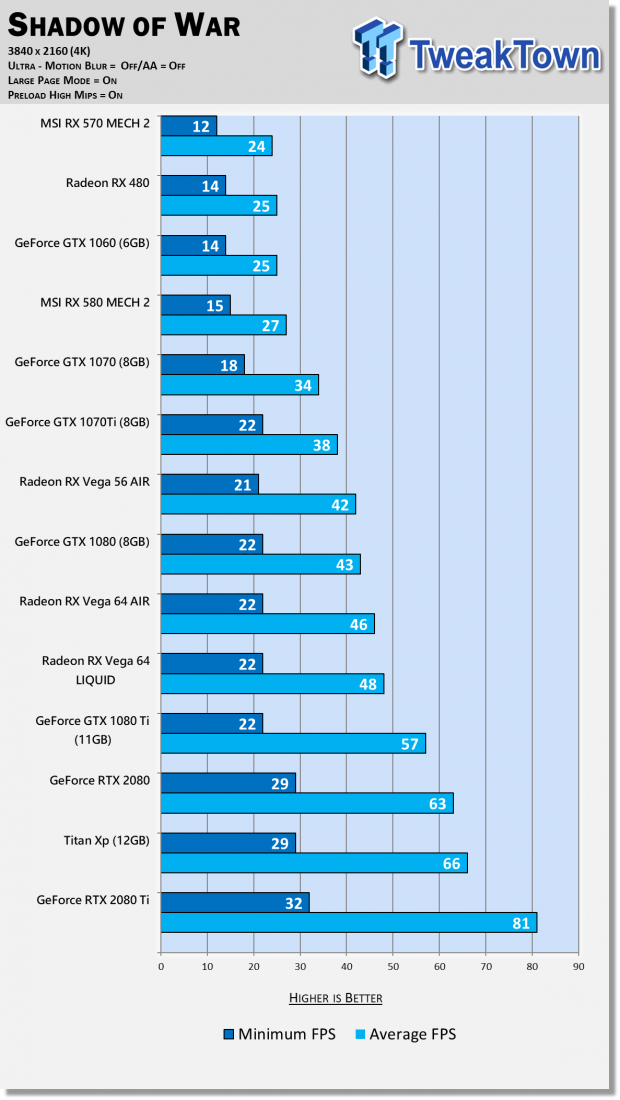
Rainbow Six: Siege has been a strong entry into the franchise, popular for its realistic feel and great graphics. Stable as a rock for benchmarking, right up to 3440x1440 and 4K.
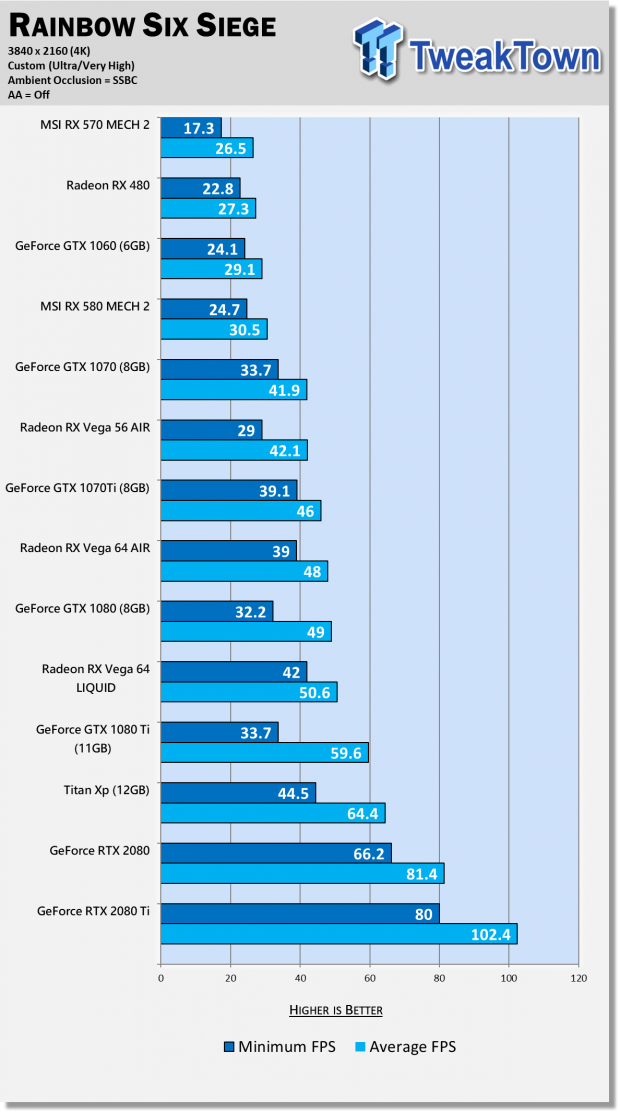
Metro: Last Light Redux comes from developer 4A Games, making the Redux version of Metro: Last Light the 'definitive' version of the game. Redux had a fresh coat of paint on the already impressive 4A Engine, and it really pushes our GPUs to their limits.
You can buy Metro: Last Light Redux at Amazon.
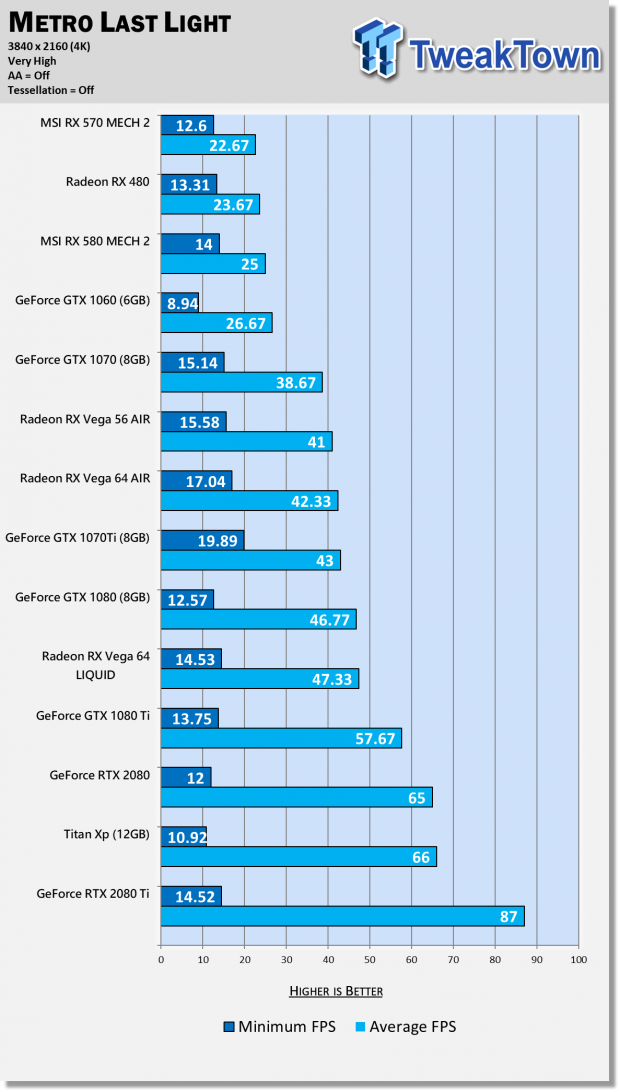
Far Cry 5 was developed by Ubisoft, and is powered the Dunia Engine, an engine that has been modified over the years for Far Cry. Dunia Engine itself was a modified version of CRYENGINE, scaling incredibly well on all sorts of hardware.
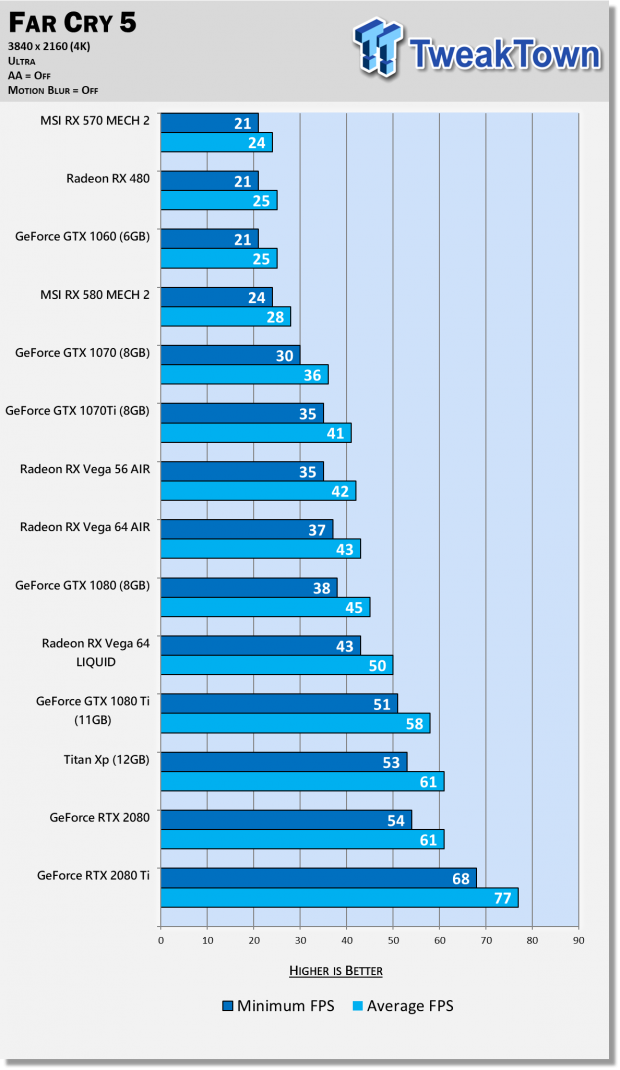
F1 2018 is the latest iteration of the super-popular franchise that Codemasters has worked on for close to a decade now, with F1 2009 kicking it all off. The game is powered by the EGO game engine, which is a modified version of the Neon game engine that was developed by Codemasters and Sony Computer Entertainment for Colin McRae: Dirt, which was released in 2007. The revamped EGO engine was developed to give Codemasters the ability of using more detailed damage and physics in the game world, as well as rendering larger-scale environments.
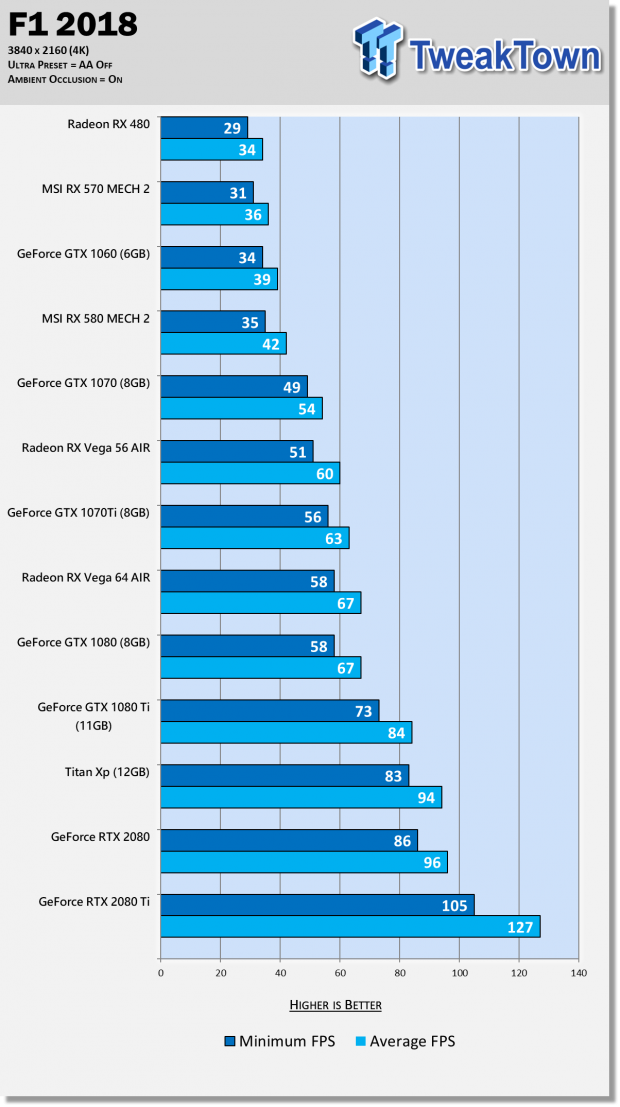
Shadow of the Tomb Raider is one of the latest games to join our graphics card benchmark lineup, with the game built using the Foundation engine as a base, the same engine in Rise of the Tomb Raider. Eidos Montreal R&D department made lots of changes to the engine during the development of Shadow of the Tomb Raider to make it one of the best-looking games out right now.
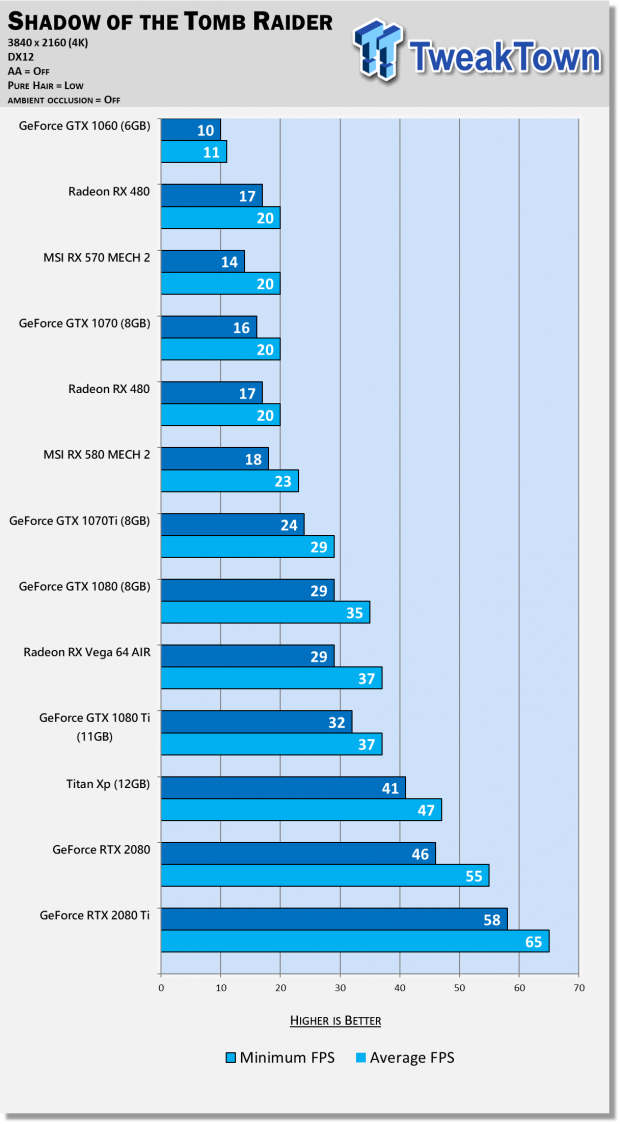
Benchmarks - 8K
8K Benchmarks
There are 7 minutes left until this review goes live (I actually typed 8 minutes but in the time of typing it went down to 7, and it'll soon go down to 6) so I simply didn't have time to get the 8K benchmarks in final form. What I can tell you is that the GeForce RTX 2080 Ti kicks ass at 8K.
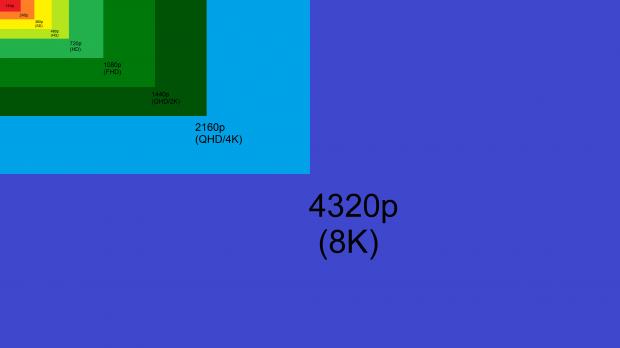
NVIDIA absolutely dominates every single resolution with the GeForce RTX 2080 Ti Founders Edition, ensuring 4K 60FPS is actually achievable without breaking a sweat. Upping the ante to 7680x4320, aka 8K really sees the card working hard. 8K 30FPS is something achievable with the RTX 2080 Ti FE, and that's pretty damn mind blowing. We have scores that are closer to GTX 1080 Ti SLI than a single GTX 1080 Ti or TITAN Xp.
There'll be a follow up article early next week on 8K gaming performance, check back then.
Overclocking
Overclocking Turing & GDDR6
I've had less than 48 hours in total with the GeForce RTX 2080 Ti at the time of writing, with 16-hour days to get all of the benchmarking and writing done. Overclocking took a back seat until I was finished with all of the results and half the review written, but this is something I'll be playing with in subsequent articles after this one. I have experimented of course, I couldn't have the card here and not OC before the review embargo, right?!
I used EVGA PrecisionX1 software (the early reviewer version) which will be different when the full version is out, and MSI's new Afterburner has Turing GPU support but arrived on the tail end of my review. I will have more detail on all of the NVIDIA Scanner-capable OC software apps from EVGA, MSI, ZOTAC and others in the custom reviews, and a round up at the end.
My sample of the GeForce RTX 2080 Ti Founders Edition could be overclocked between 1995-2100MHz, where it would float between that 100MHz stretch of GPU highway depending on the load of the card. I had the voltage at 100% to allow maximum OC (didn't have enough time to balance this all out), and the GDDR6 overclocked by 1000MHz up to 15Gbps total.
After I wrote this part of the review I played with the GDDR6 overclocking a little more and reached 16Gbps (which is quite crazy when you think about it). I have some OC performance of the overclocked RTX 2080 Ti FE that will follow this review, but we're looking at 5-10% more performance on top which is pretty crazy considering how fast the card is at stock clocks.
I had both of the fans on the RTX 2080 Ti FE at 100% to ensure the card was running cool throughout my OC testing, with it hitting 55-59C and maxing out at 60-61C. The card is loud but not as loud as the fully-spun cooler on the Radeon RX Vega 64 or GTX 1080 Ti FE and TITAN Xp graphics cards. I've got a custom ZOTAC GeForce RTX 2080 Ti AMP on-hand and will be testing that card out after this, but I can tell you this much: the custom cooler on the ZOTAC card is incredible, and keeps the Turing GPU even cooler than the Founders Edition.
At the time of writing I only have a few OC results with the RTX 2080 Ti, but I'll have a follow up article in the next 24-48 hours with OC results which are pretty impressive considering the RTX 2080 Ti already kicks the asses of every other graphics card on the market.
Heat, Power, Noise
Coolest GeForce Yet
NVIDIA has always made good but not great reference cards, putting in the most effort ever with its last-gen GeForce GTX 10 series Founders Edition cards. They were good, but they got super hot - hitting 83C without a problem and were untouchable between testing. It always made it hard doing mass benchmarks because the GTX 10 FE cards would get blistering hot. I'd burn myself every now and again when going between cards, which sucked.
Well, that doesn't happen with Turing. The new GeForce RTX 2080 Ti runs at a maximum of 70-75C during most testing with its fans on auto and only 60C maximum with the fans at 100%. I'll do more testing of the temperature of the GPU in more detail in the coming days, but the GPU doesn't get anywhere near as hot or maintain its heat like Pascal does.
The backplate on the RTX 2080 Ti Founders Edition card still stays incredibly hot, so while the GPU is running at a cool 60C with the fans at 100%, the backplate is ridiculously hot. The ends of the card don't run hot so you can still grab it, but that's where the custom RTX cards will come into play. We have one already and multiple others on the way (the typhoons near China aren't helping).
Power Consumption
Stock: I was hitting around 330-350W total under 100% stress loads, around the level of power consumption of the TITAN Xp, but a little more than a fully loaded GTX 1080 Ti. We'll have more on this soon as well.
OC: The new GeForce RTX 2080 Ti uses anywhere between 400-460W of power when overclocked, depending on the game, resolution, frame rate, and temperature of the card. With the Turing GPU and GDDR6 both overclocked, and the fans at 100% we had power consumption of up to 470W peak in Shadow of the Tomb Raider. Power consumption was anywhere between 400-430W in Metro Last Light, while it sat between 420-460W in Rainbow Six Siege.
Quietest GeForce Ever
If you leave the GeForce RTX 2080 Ti Founders Edition to its own, it will run nice and quiet for you - hitting 70-75C. This temperature isn't enough to crank the fans to 100% yet, so it'll be nice and quiet while running over 10C cooler than the GTX 10 Founders Edition cards (GTX 1080/1080 Ti/TITAN Xp).
This was one of the more impressive parts of NVIDIA's new card... it blows the performance doors off the current flagship GeForce GTX 1080 Ti and TITAN Xp graphics cards, while doing so cooler and quieter than both of those cards. Incredible stuff, really. Turing, the new power delivery system, GDDR6, and everything in between has been tuned to perfection for the RTX 2080 Ti.
Unrivaled Performance
NVIDIA is not just throwing punches with the GeForce RTX 2080 Ti, its coming through and just punching through walls. After it's punched through the wall, the RTX 2080 Ti steps into the next line in the sand of performance and firmly places its flag. The RTX 2080 Ti absolutely owns all resolutions and games, and is now the fastest graphics card you can buy.
All the hype was worth it for a 30-50% increase in 4K performance over not just the GeForce GTX 1080 Ti, but the TITAN Xp which was worth $1199 until the RTX 2080 Ti Founders Edition arrived and took its price of $1199. It's a fairer comparison to not judge the RTX 2080 Ti against the GTX 1080 Ti, but more of 'how good is the card for $1199 that replaces the TITAN Xp'.
Looking at the RTX 2080 Ti like this puts it in a class of its own. The RTX 2080 on its own replaces the TITAN Xp in virtually all resolutions and games, but the RTX 2080 Ti is a huge leap up from the already-great performance of the RTX 2080. To put it plainly, I see the RTX 2080 and RTX 2080 Ti like the arms on Henry Cavill in Mission Impossible: Fallout:
The King Of 4K Gaming
NVIDIA's new Turing-based GeForce RTX 2080 Ti kicks f***ing ass at 4K gaming, I've said it elsewhere in the review because that's the only way of explaining it. Holy hell does it throw some punches at 4K, going above and beyond what I expected over the GTX 1080 Ti and TITAN Xp. This is an entire new class of performance for $1199, putting the TITAN Xp to shame really.
Shadow of the Tomb Raider running at 4K on Ultra graphics (AA disabled) we are seeing 58/65FPS on minimum/average, respectively. This is pretty crazy when you think the GTX 1080 Ti is only pushing out 41/47FPS, respectively, giving the RTX 2080 Ti an increase of 38% at 4K.
Far Cry 5 on the RTX 2080 Ti shows similar results, with a 32% increase in performance over the GTX 1080 Ti. Rainbow Six Siege on the other hand is incredibly gracious of all of the new horsepower from Turing and GDDR6 on the RTX 2080 Ti, with a huge 73% increase in performance.
Rainbow Six Siege sees the RTX 2080 Ti pushing out 80/102FPS on minimum/average, respectively, while the GTX 1080 Ti is only capable of 32/49FPS, respectively. 73% increase in performance is absolutely incredible. For comparison, the Radeon RX Vega 64 LCE pushes 50FPS average.
Middle-earth: Shadow of War is another game hard on graphics cards, but at 4K the new GeForce RTX 2080 Ti is pushing out 32/81FPS on minimum/average, respectively. Another huge gain over the GTX 1080 Ti at 4K in Shadow of War with an increase of 42% on the RTX 2080 Ti.
I Really Want To Test NVLink
We're seeing an average of 80-100FPS at 4K on the GeForce RTX 2080 Ti, so all I can wonder is how the NVLink multi-GPU performance will be on the new Turing cards.
Even if you were to get 30-50% scaling through RTX 2080 Ti cards on NVLink, you would be pushing well past 120FPS at 4K which is just insane. It really is unheard of, and something that Vega could never come close to. I don't think we'll ever see a current-gen GPU architecture from AMD pushing past 4K 120FPS.
None of our games ran at below 60FPS at 4K on the RTX 1080 Ti, but the same can't be said for the GTX 1080 Ti or TITAN Xp graphics cards. They will drop below 60FPS average at times, but the RTX 2080 Ti just bashes through them all.
All Without DLSS... Yet
This is something I can't wait to get into, either... Deep Learning Super Sampling, or DLSS. We are told to expect a huge leap in performance with DLSS-enabled games, so not only will they look better but they'll run faster as well. These results at 4K can only go up with the adoption of DLSS meaning that your RTX 20 series graphics card can make your games run faster in the future. Awesome!
More Coming Soon & Final Thoughts 1.0
SO MUCH MORE Coming Soon
As I said earlier on in the review, I've only had around 48 hours with the new GeForce RTX 2080 and RTX 2080 Ti graphics cards. I wanted to get the main portion of this review out of the way with the larger of the two cards reviewed, meaning the RTX 2080 gets summed up here quickly in the RTX 2080 Ti review as it's already in our benchmark charts. I'll take a look at the GeForce RTX 2080 in a separate article soon.
I will have more detailed 8K benchmarks with stock and OC results, as well as upcoming NVLink benchmarks when an NVLink bridge and hopefully second RTX 2080/RTX 2080 Ti Founders Edition arrive. 4K 144Hz HDR game benchmarks will also happen, as well as more of a look into 3440x1440 performance for 21:9 UltraWide gaming monitors. I wouldn't recommend the GeForce RTX 2080 Ti to anyone on a 1080p monitor, and even a 1440p monitor is pushing it unless it's a high refresh rate 120/144/165Hz panel.
4K is where the GeForce RTX 2080 Ti stretches its legs, something you can see very obviously in our benchmark charts.
Final Thoughts 1.0
NVIDIA has released what is in my eyes, the best graphics card of all time. It's not just a faster card, it's a better card in virtually every single way. If we take the price out of the equation and look at it from purely a technological point of view, the Turing GPU architecture is a work of art. It delivers truly next generation performance and features, something that will only be fully realized in the years to come.
It has been many years since we've had a truly huge GPU architectural shake up from NVIDIA, with Pascal feeling like a more refined Maxwell and that has been the last five years of our lives with the GeForce GTX series. The new GeForce RTX series marks a monumental time: NVIDIA is putting its foot firmly onto the ground and said "this is what we want to do with the future of PC gaming" with its new real-time ray tracing technology, RTX features, and brute gaming performance from the new RTX 20 series graphics card.
So what will AMD do now? Well, if you look at the charts for the most part the highest-end flagship Radeon RX Vega 64 can barely beat the GeForce GTX 1080. Vega 64 can't compete with the GTX 1080 Ti, let alone the RTX 2080 or RTX 2080 Ti. NVIDIA has utterly redefined the high-end graphics card market by pushing the price of their GeForce RTX 2080 Ti Founders Edition to $1199, effectively killing the TITAN Xp that is the same price.
It also opens up the market for a Turing-based GeForce RTX which could come much closer to $1999 in my opinion, with up to 12-16GB of GDDR6 RAM and a full-blown Turing GPU with every bell and whistle enabled. This would leave the GeForce GTX 10 series on its own between $250-$700 covered by the GTX 1060 through to GTX 1080 Ti. NVIDIA is creating a new market between $700-$1200 that it doesn't just dominate, it's the only player. They have effectively shifted the entire graphics card market on its head and then drawn new lines in the sand with RTX.
I'm utterly blown away by the GeForce RTX 2080 Ti. Totally blown away.
So many people will get triggered over its huge $1199 pricing, but comparing it to the previous $1199 card in the TITAN Xp, it blows it away. If NVIDIA had provided 5-10-15% more performance over the TITAN Xp in the RTX 2080 Ti, I would've been impressed. More performance at that level of the graphics card industry is unheard of. AMD couldn't come close to the GeForce GTX 1080 Ti, hell it was blindsided by it when they unveiled Vega at Capsaicin 2017.
NVIDIA held its own surprise launch event for the GTX 1080 Ti blowing everyone away. I knew people at AMD who were shocked at the sudden announcement and release of the GeForce GTX 1080 Ti. AMD knew it could never beat the GeForce GTX 1080 Ti, something that was launched before Radeon RX Vega 56 and 64, and absolutely dominated it until now. HBM2 and HBCC alongside the new Vega GPU architecture weren't enough in that form to compete against Pascal let alone Volta and now Turing.
The use of GDDR6 has been incredible, with NVIDIA the first with the new super-fast memory standard being a big upgrade over GDDR5X on the GTX 1080/1080 Ti and TITAN Xp. AMD went with HBM2 and it ultimately failed on Vega, but the implementation of GDDR6 on the new GeForce RTX cards is a big winner for NVIDIA. Starting at 14Gbps is incredible, as it can scale to 18-20Gbps giving us far more memory bandwidth than even HBM2 in its current form.
Should You Buy It? & Final Thoughts 2.0
Should You 'Just Buy It'?
Should you buy the new GeForce RTX 2080 Ti? For the most part it's a resounding 'YES!!!' but there are a few things to note:
If money was out of the question: Absolutely yes. It costs the same as the TITAN Xp, and offers magnitudes more performance. Most enthusiasts who don't worry about the money aspect of buying hardware (there are plenty, we all know at least one person like that) will find an amazing product with the GeForce RTX 2080 Ti. Unrivaled performance, that no other graphics card on the market comes close to.
1080p/1440p monitor owners: No. I think the new GeForce RTX 2080 Ti at $1199 (at least in Founders Edition form) is too expensive for 1080p monitor owners. 2560x1440 panels with 60Hz refresh rates won't benefit too much from the Turing GPU architecture, unless you cranked every single in-game visual detail up. You could use AA or DLSS (if it's supported) and enjoy massive frame rates at 1440p on the RTX 1080 Ti. I would be checking the performance of the games you play most on the new RTX 2080 Ti. If there's something you want me to test, let me know in the comments below.
DLSS: This is one of the key parts of the new Turing GPU architecture, Deep Learning Super Sampling. DLSS can really change everything for GeForce RTX series graphics card owners, as NVIDIA's own deep neural network will eventually improve DLSS-supported games so that they not only look better, but they have huge performance gains. NVIDIA is practising magic, I know it.
4K monitor/TV owners: Abso-effing-lutely. NVIDIA's new GeForce RTX 2080 Ti is almost magic, it is as close to magic in a graphics card we've ever had. 4K performance is out of this f***ing world, there's no other way to explain it. We're seeing 4K 60FPS and beyond with the RTX 2080 Ti, and that's without DLSS enabled. Some games are pushing 4K 120FPS with Ultra detail enabled, so if you knocked some of those down the GeForce RTX 2080 Ti can feed out 4K 120FPS right now. INCREDIBLE.
Upgrading to 4K 144Hz: This is the best use case of the GeForce RTX 2080 Ti... 4K 144Hz HDR G-Sync gaming monitors. They might cost $2000, but if you were spending that much money on a gaming display then outlaying $1199 on a new RTX 2080 Ti Founders Edition is no problem, right? It's the only card on the market that offers beyond TITAN Xp performance (for the same price you're getting a HUGE performance increase).
RTX/real-time ray tracing games: OBVIOUSLY. This is the absolute pinnacle of the Turing GPU architecture: real-time ray tracing with RTX supported games. There are gigantic games with the likes of Battlefield V, Shadow of the Tomb Raider, Metro Exodus and so many more that are adding RTX support. I expect that post-launch we'll see countless more games announced with RTX abilities.
3440x1440 monitor owners: This is another resolution that has really needed a new card. 3440x1440 is a great resolution, one of my personal favorites, except that it doesn't warrant dropping $1199 on the TITAN Xp for its performance jump over the GTX 1080 Ti. The new GeForce RTX 2080 Ti on the other hand, is worth dropping $1199 on a new 3440x1440 - especially if it can crank to 100-120Hz, which the RTX 2080 Ti can easily provide 120FPS for at 3440x1440.
Enthusiasts: I'm leaving enthusiasts until last. I'm an enthusiast, take my job away from TweakTown and I would've pre-ordered one of these cards on day one. If it was only 10-20% performance leap over the GTX 1080 Ti it would only be 5-10% faster than the TITAN Xp which is replaces in the price stack of cards from NVIDIA. But the GeForce RTX 2080 Ti is something special. Overclocking headroom is awesome on the card, RTX features and AI/deep learning features are amazing, too.
Enthusiasts will feel more at home with the new Turing GPU and GDDR6 memory as there's so many new tricks, games, features, and unrivaled performance inside of the new RTX 20 series cards that we're simply too early to really take it all in. I think enthusiasts will have the most fun with Turing, as NVIDIA is wholly embracing overclocking with the RTX series, a first for the company. One-click OC? That's insane.
Final Thoughts 2.0
NVIDIA has raised the bar on the entire graphics card market with the new Turing GPU and GeForce RTX series of graphics cards. AMD can't just enter with a mid-range Navi GPU and not expect the entire world to ask 'so are you going to compete with NVIDIA's new GeForce RTX 2080 Ti graphics card?'. That will happen, and the response from AMD will be a decider on how 2019 will fare for the graphics card market.
AMD's flagship Radeon RX Vega 64 still costs $580 on Amazon at the time of writing, in the form of an overclocked ASUS ROG STRIX Radeon RX Vega 64. AMD has nothing higher than that for gamers, so the new RTX 2080 and RTX 2080 Ti sit alone in their beyond-enthusiast reach from AMD. If you have a 4K gaming monitor you're not hitting 60FPS with everything on Ultra in most games on Radeon, but now there's a card where you can: RTX 2080 Ti.
If you want the best gaming performance, period, then you will want to buy the GeForce RTX 2080 Ti. If you were interested in buying the expensive new 4K 144Hz HDR G-Sync gaming monitor, until now there was nothing that could get close to feeding it 4K at 144FPS... but now there is. I've only had it for a few hours, but I used the GeForce RTX 2080 Ti on my 4K 144Hz HDR G-Sync monitor and played Overwatch at 4K on Ultra graphics (minus AA) and it was sublime.
I've never had a smoother Overwatch experience, especially at 4K than I did with the RTX 2080 Ti. Until the Turing GPU, I had the NVIDIA TITAN Xp in my 8700K gaming rig which was good for 100-120FPS average in Overwatch at 4K on Medium. I'm now running 4K Ultra and hitting 130-150FPS average, while at Medium on the RTX 2080 Ti it was running at 150FPS minimum so it was beyond liquid smooth.
At $1199, the new NVIDIA GeForce RTX 2080 Ti Founders Edition is the most expensive GeForce ever, but is it all first adopter tax and price gouging because there's no competition? Well, think about it: we have a totally new GPU to manufacture (Turing in TU102 form) as well as 11GB of expensive, and super-fast GDDR6 memory. The GPU is made on the new 12nm process and with 18.6 billion transistors, it's not something that can be mass produced with millions of cards sold per month.
We're walking into new territory right now, and people are going to think "is NVIDIA able to charge $1199 for the RTX 2080 Ti FE because Vega sucked?" and it is a very, very valid question. Yes, NVIDIA can and they should charge $1199. This is a new market, folks. The prices are being set this high because unfortunately NVIDIA can do whatever the hell it wants. They're the ones investing billions and billions into R&D into these new technologies, constantly pushing the envelope further and further.
NVIDIA should be commended with a standing ovation for not just the Turing GPU architecture, but the moves they've been making for the last few years. PC gamers have benefited in so many ways, and I don't think there's a way to even see all of what NVIDIA has done as a whole. It's not just new GPU technology that NVIDIA continues to break new ground in (seriously, a hat trick of GPU architectures in Maxwell, Pascal, Volta - and then it all starts again with Turing) - but it's everything else.
- GeForce Experience
- ShadowPlay (game recordings)
- Ansel (game screenshots/more)
- Self-driving car tech
- AI/deep learning
- BGFD TVs (4K 120Hz HDR G-Sync)
- 4K 144Hz HDR G-Sync
- SLI/NVLink
- HairWorks
- HBAO+
These are NVIDIA technologies just off the top of my head without Googling more, NVIDIA is pushing the boundaries and creating new products to fill new markets. 65-inch 4K 120Hz HDR G-Sync gaming displays? No one else does that. ShadowPlay is an amazing tool used by tens of millions of gamers. AMD isn't close on that, period. Self-driving car tech might not be heavily used now, but I want a company like NVIDIA doing it simply because they can.
The gaming market for NVIDIA is its most important, with GeForce representing over half of NVIDIA's revenue each quarter. NVIDIA needs to dominate the gaming GPU market because it holds the highest percentage and it eats, breathes, and bleeds gaming as a company. AI is another market that NVIDIA is quickly becoming the king of, powered by its deep learning technology and deep neural networks. The company is firing on all cylinders and is a champion of so many of them. Sometimes, without competition at all... not even a whimper.
If AMD wants to compete in this market they're going to have to join a new price range offering performance at equal to Turing and the RTX 2080 Ti for let's say, $1000. I really can't see this happening as it would mean Navi is scaling from consoles (PS5) through to beyond Vega and into Turing territory. I can't see this happening either, so it could be Vega 20 on 7nm with GDDR6. Until now, Vega was meant to be locked to HBM2 technology - but if Vega 20 was made on 7nm and used GDDR6... we might see Turing level performance.
At that stage, the 7nm production and use of Vega 20 and HBM2 in games comes into play - is Navi the mid-range (1080p 60FPS and 4K 30FPS) while the new Vega 20 with GDDR6 could offer 4K 60FPS and above. No one knows at this point, but I expect an update from the RTG team after the launch of the GeForce RTX cards. I'm hoping it's something, and the tease can't be something they can't deliver - AMD need to either completely leave this new market to NVIDIA to dominate (admitting defeat of the high-end PC graphics card industry) or enter it, and compete or beat NVIDIA.
Vega sucked. We all know it did. AMD - you'll read this, and I want you to know it. You tried, and it failed. Vega can be great, and Vega 20 on 7nm will actually be exciting alongside the current domination with Ryzen/Threadripper, AMD is doing really well. Radeon on the other hand, I'm sorry - but as an enthusiast of over 20 years, Radeon is dead right now. RX Vega 64 doesn't impress me technologically, or in performance. But that doesn't mean Radeon is finished, there is a glimmer of hope from Vega 20 and Navi in 2019.
What Will AMD Do & Final Thoughts 3.0
What Will AMD Do?
If AMD wants to compete in this market they're going to have to join a new price range offering performance at equal to Turing and the RTX 2080 Ti for let's say, $1000. I really can't see this happening as it would mean Navi is scaling from consoles (PS5) through to beyond Vega and into Turing territory. I can't see this happening either, so it could be Vega 20 on 7nm with GDDR6. Until now, Vega was meant to be locked to HBM2 technology - but if Vega 20 was made on 7nm and used GDDR6... we might see Turing level performance.
At that stage, the 7nm production and use of Vega 20 and HBM2 in games comes into play - is Navi the mid-range (1080p 60FPS and 4K 30FPS) while the new Vega 20 with GDDR6 could offer 4K 60FPS and above. No one knows at this point, but I expect an update from the RTG team after the launch of the GeForce RTX cards. I'm hoping it's something, and the tease can't be something they can't deliver - AMD need to either completely leave this new market to NVIDIA to dominate (admitting defeat of the high-end PC graphics card industry) or enter it, and compete or beat NVIDIA.
Vega sucked. We all know it did. AMD - you'll read this, and I want you to know it. You tried, and it failed. Vega can be great, and Vega 20 on 7nm will actually be exciting alongside the current domination with Ryzen/Threadripper, AMD is doing really well. Radeon on the other hand, I'm sorry - but as an enthusiast of over 20 years, Radeon is dead right now. RX Vega 64 doesn't impress me technologically, or in performance. But that doesn't mean Radeon is finished, there is a glimmer of hope from Vega 20 and Navi in 2019.
Final Thoughts 3.0
I didn't think I'd get to 24 pages and over 10,000 words but here we are. NVIDIA's new GeForce RTX 2080 Ti is a game changer in more ways than one, and deserves all of the attention it will get. It's bloody expensive, freaking fast, and bursting with so many new features you can't even use them all yet.
The GeForce RTX 2080 Ti is the first graphics card I've ever tested that I've had to go back and re-benchmark a few 3DMark runs and games, because the results seemed off... the RTX 2080 Ti was so much better than the TITAN Xp and even the RTX 2080 that I had to spend hours re-benchmarking to be 100% sure. Once that benchmarking was complete, the numbers lined up and it was just that fast. I've never tested a card that stomps on all the previous cards so much you need to double check the data because it seemed like too far of a jump.
2560x1440, 3440x1440, and 4K monitor owners all have a new card that guarantees the very best performance possible: NVIDIA's new GeForce RTX 2080 Ti. Unrivaled performance, a completely relentlessly awesome graphics card that is so good it has raised the bar that high it has set a new standard in not just performance, but price.
At $1199 the NVIDIA GeForce RTX 2080 Ti is the most expensive graphics card on the market, bar the TITAN V - which I don't take into consideration in this review. Gamers will only buy the GeForce GTX 1080 Ti and TITAN Xp, both of which get decimated by the GeForce RTX 2080 Ti in every single test. People were happy buying the TITAN Xp for $1199 and getting more performance than the GTX 1080 Ti. Well, that same money gets you a massive performance over the TITAN Xp, which is insane when you think about it.
NVIDIA can't leave the TITAN brand out there without a Turing GPU inside, which is where I want to see a TITAN RTX released with 12-16GB of GDDR6 and some serious upgrades in performance. We could have the world's first 4K 120FPS graphics card with a purported TITAN RTX as we're so very close as it is with the GeForce RTX 1080 Ti. A purported TITAN RTX could be anywhere between $1499-$1999 if it were to be made a reality, and I don't see why NVIDIA wouldn't do it.
The new TITAN RTX could be an ace up NVIDIA's sleeve for when they launch their Big Format Gaming Displays in 2019. Think about it: BFGDs come in at a huge 65-inch with a super-fast 144Hz refresh rate, as well as HDR and G-Sync technologies. You can't just plug any 'ol graphics card into it and start cranking through the latest games (and in 2019 no less) on a GTX 760.
You're going to need some out-of-this-world graphics card like a purported TITAN RTX that can drive 4K 120FPS in a bunch of games, while dropping details down a little bit on a card as fast as that would ensure most games would run 4K 120FPS on a BFGD. 2019 is going to be a helluva year, that's for sure.
All-in-all, NVIDIA has redefined the enthusiast level of graphics cards with the new Turing-based GeForce RTX 2080 Ti. Even at its swollen $1199, it is amazing value for money considering just a few weeks ago people were buying the TITAN Xp for the same price and were, like me, happy with its performance lead over the GTX 1080 Ti. But now the $1199 spot is dominated by the RTX 2080 Ti, and its worthy of its position.
How long the GeForce GTX 10 series stays on shelves will be the question, or will they fill out the RTX series with more cards next year and have the new minimums of the RTX 1060 start higher at $399+ or so. There are some gamers who don't want to pay the additional costs of AI and RTX technologies on a card, they might want to play other games that don't use these technologies. Why should they be forced into spending more on the card?
But on the flip side, NVIDIA could pump many older and eSports level games through its DNN and give us DLSS support so the games run far better on RTX series cards, and look better than our games now without AA enabled, or with 4x AA. This is where things can get really interesting for NVIDIA, but I do wonder about the GTX 10 series longevity on the market post-RTX launch.
The new king is here everyone, welcome the GeForce RTX 2080 Ti. How long will this be the #1 card? 6 months? A year? 18 months? Longer? At this rate, NVIDIA is the only one that could succeed it, unless Skynet does it first.

